|
Paper 33
James and Martin Platts,
Dance Publishers, 1780s-1820s
Contributed by Paul Cooper, Research Editor
[Published - 18th January 2019, Last Changed - 25th April 2024]
James and Martin Platts, probably brothers, were amongst the most interesting social dance creators and music publishers of the 1780s through 1820s. They've appeared several times in our research papers, but always in a minor or supporting capacity; it's time to rectify that oversight - they're of more than sufficient significance to be worthy of study in their own right. The Platts family issued numerous dance collections and pioneered several new dance trends, their activity spans and illustrates a period of time in which important changes swept their industry.
The Platts Family
The Platts family, over three generations, were active as musicians, instrument makers, publishers and dance directors. They had their difficulties too, perhaps even a schism; the details of the argument are lost, but a split of some kind complicated the historical record. Our interest will focus on three members of the family, Martin Platts (Senior), and his two sons James Platts and Martin Platts (Junior). The two presumed brothers both published collections of social dances, some of which remain of great interest for modern enthusiasts.
The only existing biography I've found for the Platts family is that recorded in A Biographical Dictionary of Actors, Actresses, Musicians, Dancers, Managers & Other Stage Personnel in London, 1660-1800 (which will hereafter be referred to as the Biographical Dictionary), a copy of which is available online. That biography notes many doubts about the Platts and offers a confusing summary; I hope to offer a simpler narrative of their story, though fresh evidence may yet emerge to disambiguate their story further.
Martin Platts (Senior), c.1737-1807
The elder Martin was a father of at least four children, including his two sons. Relatively little is known about him. Doane's Musical Directory for the year 1794 (see figure 2) identifies three members of the Platts family as being active at that date, including Martin who was reported to be living at 9 Lovel's Court (see Figure 3); he was evidently a Violin player and a member of the Royal Society of Music. We know from the cover of some of James' publications that Martin (Senior) taught the Harp; for example, the Book 1st for the year 1796 advertised The Pedal Harp taught by Martin Platts and Sons, No 9 Lovells Court, Paternoster Row; Provides Music for Balls and Assemblies, Orders received for them as above .
Martin's Will is available for study through the National Archives, he died in mid 1807. The Will reveals that Martin was married to Margaret Platts and they were still living at Lovel's Court at the date of his death. Most of his estate was left to his son James, together with some provision for Margaret and his two married daughters (Elizabeth, and another daughter whose name I've struggled to read). The Will makes no reference to Martin Platts (Junior), it's evidence of the family split having already occurred at this 1807 date, this is a topic we shall return to shortly. It's possible, though entirely speculative, that Martin was married more than once, his sons may have had different mothers.
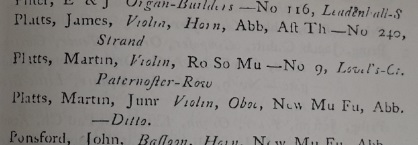
Figure 2. The Platts family entries in Doane's Musical Directory for the year 1794.
There is a mystery involving Martin (Senior); the Biographical Dictionary notes that two Platts boys were enrolled as apprentices in the Worshipful Company of Musicians; both James Platts and Martin Platts (Junior) were identified as being the Son of Martin Platts of St Faith's London, Cit[izen] & Blacksmith . The identification of Martin as a blacksmith is strange, though not all that unusual. Musical instrument makers at this date did not have their own liveried company, if they wanted to trade within the city of London then they had to register with another profession's guild; some might register as Cooks, Spectacle Makers, Stationers, etc.; it seems likely that Martin registered as a Blacksmith, though purely for convenience purposes. He was not a blacksmith by trade, but was professionally registered with the Worshipfull Company of Blacksmiths in order to trade within London. If this theory is correct, the reference to his being a Blacksmith is not problematic. This possibility significantly simplifies the Platts story compared to that given in the Biographical Dictionary (where an additional generation of Platts brothers featuring the names James and Martin is theorised to have existed).
Martin Platts (Junior), 1761-1817

Figure 3. 9 Lovel's Court (or Lover's Court on this, the Horwood Map of 1792-9) home of Martin Platts (Senior) slightly north of St Paul's Cathedral; and the Blue Coat Buildings home of Martin Platts (Junior). © THE BRITISH LIBRARY BOARD, HUS 050
The younger Martin, presumably the elder of the two brothers, was probably born in 1761, a date calculated from his 1817 obituary. He is recorded to have begun his apprenticeship under William Burnitt on the 18th September 1776; he served 7 years as an apprentice and was admitted into the Worshipfull Company of Musicians in 1784. He was declared to be proficient on the Violin and Horn, and was recorded to have been engaged at Brighton.
It was (presumably) in 1784 that he became an assistant to the great dance publisher Francis Werner. Werner was a musician and dance director, he published some of London's most interesting dance collections of the 1770s and 1780s. Werner died in 1786, bringing his sequence of annual dance collections to an end. Two different attempts were made to continue the series, one of which was made under the name Martin Platts Junior. Werner had ceased his publication series at Book XVIII (or possibly at XIX, the record is unclear), Platts probably started his series at Book XIX, the earliest number I know to have existed was Book XX for the Year 1787. Martin described himself on the cover of Book XX as Assistant and Successor to the late Mr Francis Werner . He went on to add: The Pedal Harp &c. taught and Music provided for Balls and Assemblies by Mr Platts Junr, No 316 behind the new Church in the Strand . Martin had also issued advertisements in 1786 and 1787 promoting himself as Werner's successor, an example in The World for 13th November 1787 records: M Platts, Junior, No 316, behind the New Church, Strand, assistant and successor to the late Mr Francis Werner of Pultney-street, Golden square, begs leave to return his most grateful thanks to the Nobility, Gentry, &c. for their kind encouragement, since Mr Werner's decease, and most respectfully informs them, he continues to perform on the Pedal-Harp, and direct the proper figures to Cotillons and Country Dances. Likewise provides the best Performers for Concerts, Balls, and Assemblies. N.B. Teaches the Pedal-Harp, Violin, &c. on the most approved methods. Boarding Schools attended, in town or country .

Figure 4. Martin's announcement concerning his lack of a connection with another trader of the same name, as featured on the cover of each number of Martin Platts' Periodical Collection of Popular Dances issued in the 1810s.
It's likely that Martin issued at least 6 numbers of this new series of publications. Book XXII for the Year 1788 was described as being to be had of the Author, No 4 Dukes Court, Bow Street, Covent Garden . Book XXIII for the Year 1791 recorded that M. Platts Junr plays the Country Dances and Cotillons on the Harp, and directs the proper Figures, likewise provides Music for Concerts, Balls and Assemblies at his House No 62 Stanhope Street, Clare Market . Book 25 for the year 1798 carried a similar notice, but his address was given as: No 1 Blue Coat Buildings, Little Britain (see Figure 3). He would remain at the Blue Coat buildings for the rest of his life. He clearly moved address several times in the 1790s; Doane's Musical Directory for the year 1794 (see Figure 2) gave his address as being shared with his Father at 9 Lovel's Court, perhaps it was a suitable address from which to contact him. Doane also recorded that he played both the Violin and Oboe.
Martin was married in 1789 to Sarah Vanhagen, he had a son called Thomas Martin Platts who became his apprentice in 1805. The nature of the split between Martin and both his father and brother is unclear, as previously noted he was absent from his father's Will in 1807. He published at least 12 numbers of Martin Platts' Periodical Collection of Popular Dances, Waltzes, &c. in the 1810s, each edition of which carried a notice on the cover: Mistakes having frequently occurred there being another person who plays the Harp of the same name, but with whom M. Platts has no connexion, it is respectfully requested that all Orders may be particularly addressed to Martin Platts, No 1, Blue Coat Buildings, Little Britain (see Figure 4). James Platts issued a similar collection of publications at a similar date, and he also taught the pedal-harp, Martin must surely have been referring to James in this prominent message. He disavowed any connection with his brother, at least at first; the court records for one of James Platts' copyright disputes indicates that Martin may have acted as James' agent in the purchasing of foreign tunes c.1814; if true, perhaps the argument was resolved by that date.
Martin died on September 7th 1817, his Will is available through the National Archives. The Biographical Dictionary notes that his widow Sarah drew a subsistence from the Royal Society of Musicians from 1825; it's unclear why she had to wait so long to begin claiming.
It should perhaps be acknowledged that there is some doubt over the identity of Martin Platts; it is possible to construct a logically plausible argument that two different and unrelated people operated under the name Martin Platts Junior concurrently, and that the narrative presented here squashes events from their two separate lives together. This seems improbable, but the record isn't entirely clear.
James Platts

Figure 5. Various addresses used by James Platts; both 320 and 340 Oxford Street, and 9 John Street (since incorporated into Great Portland Street). From the Horwood Map of 1792-9, © THE BRITISH LIBRARY BOARD, HUS 050
James was, presumably, the younger of Martin Platts (Senior)'s two sons; his date of birth is uncertain and there's a further mystery concerning him.
The Biographical Dictionary records of James that he was bound apprentice to Thos Whittell (of the Worshipfull Company of Musicians) for seven years from July 1788. It estimates from that date that James was born in 1774 and completed his apprenticeship in 1795. These dates are problematic however as our James Platts was publishing music independently from around the year 1791... he couldn't have still been an apprentice at that late date. The Biographical Dictionary argues that there must have been two different musicians with the name James Platts operating concurrently, perhaps different generations of the same family.
A potential explanation for the disparity in dates can be imagined however; it's possible that James was first apprenticed to his father as an instrument maker within the Blacksmith's Guild, then transferred to the Musician's Guild in 1788 following the 1785 sale of Blacksmith's Hall. Perhaps he was granted special dispensation to serve a token year as apprentice in order to transition over from the failed guild to a guild better suited to his profession. If we accept this somewhat tenuous supposition, we might infer that James was born in the 1760s and completed his apprenticeship for the second time c.1789 - these dates are more consistent with what might be predicted. The possibility nonetheless remains that the editors of the Biographical Dictionary were correct, and that two generations of brothers existed with a James and Martin in each generation, but with little other evidence for their existence, and perhaps a third unrelated Martin Platts existed too, and they all worked as musicians in London at around the same date (and in some cases just a few streets apart, see Figure 3).
However it came to be, our James began publishing music c.1790. Some of his most interesting early publications were the collections of Waltzes issued in 1791 and 1792, they're the earliest such publications to be registered for copyright purposes at Stationer's Hall. The 1791 publication was advertised (The World, 26th January 1791) as follows: Four favourite Waltz, adapted for the Harp, Harpsichord, and Violin, with their proper Figures. Composed by James Platts. London: printed for the Author; and sold by him, at his house, No 9, Lovel's-court, Paternoster-row, Cheapside; and at the Music Shops . He was evidently using his father's address at this date. The cover of his Four New Schleifers or Waltzers for 1792 lists several of his other musical publications by the same author including Oh dear! Oh dear! no hopes for Jonas, as sung by Mr Bannister Junr in the Island of St Marguerite, and Ah why was Mary so unkind, sung by Mr Cook at the Anacreontic. His music was evidently being used at some of London's minor theatres. Early 1792 saw the registration for copyright purposes of his A Favorite Lesson for the Harpsichord or Piano-Forte for Juvenile Performers, and a very interesting medley dance called La Mêlange, or Longways for as Many as Will.
Doane's Musical Directory for the year 1794 (see Figure 2) identified James as a player of the Violin and Horn, and gave his 1794 address as 240, The Strand. James's Book 1st for the Year 1796 didn't provide an address, but it did advertise The Pedal Harp taught by Martin Platts and Sons, No 9 Lovells Court, Paternoster Row; Provides Music for Balls and Assemblies, Orders received for them as above . By 1798 in his Book 3rd James was describing himself as a Professor of the Pedal Harp , and gave his address as 6 Johnson's Court, Fleet-Street; he continued to advertise Musicians for Balls & Assemblies as above & at N.9 Lovels Court . His Book 4th for the Year 1799 changed his title slightly, he was now a Professor of the Harp, Violin and Tamborino , he removed his personal address and retained only his father's Lovel's Court address on the cover.
James spent some time in Dover and Canterbury in the late 1790s. He advertised (Kentish Gazette, 17th November 1797) that Mr James Platts, teacher of the pedal harp, piano forte and violin, begs leave to acquaint the Nobility and Gentry resident in the vicinity of Dover, that his stay in that town will be till the 23rd of December; he therefore solicits a continuance of the same patronage which encouraged his stay in that neighbourhood last spring: and informs such Ladies and Gentlemen, as may have occasion for his service, that he has been in the habit of playing and teaching the figures of all the newest and most fashionable German, Welch, Scotch and Irish Dances, &c. &c. . He went on to advertise his third book of dances for 1798, and added Harps, piano fortes, harpsichords, guitars and violins, tuned and strung . It is implied that James was not just a musician, but also a teacher of dancing. A similar advertisement published a few months later (Kentish Gazette, 20th April 1798) reads: Mr J. Platts, Teacher of the Tamborine, Harp and Violin, at Mr. Bing's, Snargate-Street, Dover, begs leave to acquaint the Nobility and Gentry resident in the vicinity of Dover and Canterbury, that his stay at Dover will be till the beginning of June; he therefore solicits a continuance of he same patronage he has before experienced. P has brought with him, from London a small, but elegant assortment of ladies and gentlemens' tamborines, likewise a remarkable fine ton'd pianoforte, with extra keys, and a small collection of second hand music. Platts would be happy to attend any number of ladies or gentlemen (not less than four) as far as Canterbury, twice a week. Terms for the tamborine, 5s per lesson. Just published Six Rondo's for the pianoforte, with an accompaniment for the tamborine, price 3s, also his Book of Dances for 1798, price 1s 6d. .
James was particularly vocal in promoting the tambourine as a musical instrument in the late 1790s. The same collection of Six Rondos advertised in Dover was available in Edinburgh later that year, Muir, Wood & Co advertised it as being sold from their shop in September (Caledonian Mercury, 22nd September 1798). James' Book 4th for the Year 1799 included an arrangement of the dances for the tambourine, together with a brief essay on the new musical notation he'd felt necessary to invent for the tambourine. He advertised it (The Observer, 17th February 1799) as follows: Tambourine Music - Just published, price 2s - J. Platt's Dances for the Year 1799 - This being the first Book ever published with a Tambourine Accompaniment, P. humbly solicits the patronage of the Amateurs on the above Instrument. . It's unusual to find a percussive accompaniment to dances, James was aware that he was pioneering something new.
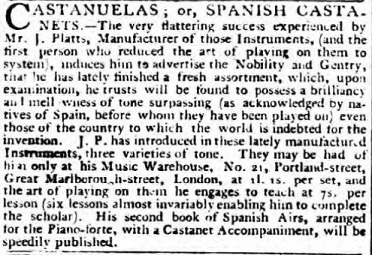
Figure 7. The Morning Post, 14th February 1805. Image © THE BRITISH LIBRARY BOARD. ALL RIGHTS RESERVED. Image reproduced with kind permission of The British Newspaper Archive ( www.britishnewspaperarchive.co.uk)
By 1804 James was once again promoting a new musical instrument, this time the Spanish Castanets (see Figure 6). Several of his advertisements for them exist, the most interesting was published in the Morning Chronicle for 26th March 1804: Mr James Platts, Teacher of the Castanets (and the first person who in this or any country reduced performance upon those instruments to a regular system,) begs leave to caution the Nobility and Gentry against certain impositions which have been practised by persons selling Castanets as of his manufacture. The very great success he has met with, and deservedly as he flatters himself, from having obtained the art of giving a brilliancy of tone equal, or even superior, as acknowledged by Native of Spain, before whom they have been played on, to those of Spanish manufacture, has allured others to make them, and pass them off as his. The secret of preparing them having cost him a great deal of labour and expense, and naturally hoping to reap the fruits of his assiduity, he requests that those who have purchased them of him will be so good as to suffer him to stamp them with his name, without which in future all sold as of his make may be known to be spurious. . He went on to note as a footnote that The set which Miss De Camp performs with in the Caravan were made by Mr Platts, and may be heard in the most remote part of the Theatre. He ended by advertising a collection of Dances arranged for the Castanet (of which I know of no surviving copies), and gave his address as No 21 Portland-Street, Great Marlborough-Street. A similar advertisement in the Morning Post a year later (14th February 1805, see Figure 7) repeated much of the same text, but added that His second book of Spanish Airs, arranged for the Piano-forte, with a Castanet Accompaniment, will be speedily published. . He once again advertised dances arranged for the castanets in 1806 (Morning Post, 10th January 1806), and a new model of castanets in 1809 (Morning Post, 2nd May 1809): ... he has lately finished a fresh assortment, which, upon examination, he trusts will be found to possess a brilliancy and mellowness of tone surpassing, as acknowledged by natives of Spain, even those of that country. . The 1809 advertisement lists his address as No. 83, Berwick-Street, Oxford Street.
At some point around 1807 he began publishing a series of Popular and Original Dances, each edition of which would include maybe 6 dances with a bass accompaniment. They followed a similar format to those issued by many of London's other music shops at the same date, the 9th and 10th numbers were advertised in the Morning Post for the 1st Match 1809, and the 11th and 12th numbers were advertised in the Morning Post for the 2nd May 1809. Numbers 18, 19 and 20 were advertised in the Morning Post for 29th June 1810. A 27th number was mentioned in an advertisement from 1811 (Morning Post, 23rd January 1811), and the 37th and 38th numbers in 1813 (Morning Post, 16th November 1813). A 43rd number was advertised in 1814 (Morning Post, 5th December 1814), by which date his address had changed to No 320, Oxford Street (see Figure 5). The 45th number was advertised in 1815 (Morning Post, 6th March 1815) together with the 4th volume of his Waltziana: being a collection of Waltzes expressly for dancing, in complete sets, composed and arranged by Platts . The 48th number was advertised in 1816 (Morning Post, 31st May 1816), and a 51st number some years later in 1821 (Morning Post, 8th March 1821). A large volume of the publications were issued between about 1810 and 1811, possibly achieving a monthly status for a brief period, the rest were issued at odd intervals. Numbers 13 through 15 were registered for copyright purposes at Stationer's Hall in December 1810, though they were probably published in 1809; they contained tunes that would subsequently be of relevance to James in his legal disputes of 1815, perhaps he had a premonition that they would be legally important such that he registered those specific numbers (rather than some of the newer numbers that ought to have been in-hand in late 1810). The early numbers of the series contain popular tunes known from across the industry, but from approximately the 10th number James focussed on selling tunes that he'd composed himself.
James was involved in several copyright disputes in the mid 1810s, with mixed results, we've written about them elsewhere. He lost at least one dispute with Button & Whitaker, but he probably won another against Charles Wheatstone. He was declared bankrupt in 1816, though he evidently continued to trade thereafter. He was married to Sarah Northleigh in 1811, they had a son Charles Platts together in 1813.
He advertised Platts's Quadrilles, 1st Book in 1817 (Morning Post, 27th February 1817) giving his address as 340, Oxford Street (see Figure 5), and My Grandmother's Quadrilles in 1820 (The Times, 8th November 1820), with an address at 9, John Street, Oxford-Street, near Regent-Circus (see Figure 5). This appears to have been his final address, he was still operating from that residence in 1829 (Morning Chronicle, 27th May 1829).
I don't know when James died, but the Morning Advertiser for the 10th January 1834 carried a report of his widow's passing: Died, On the 2d inst., Mrs Sarah Platts, widow of Mr James Platts, of John-Street, Oxford-Street, music-seller, aged 54 . A year later a Charles Platts was advertising sale of music from the same address (Morning Post, 25th March 1835). James must have died in the early 1830s (his insurance records exist for 1831), his dance publishing career having spanned some 30 or more years.
The Platts' Contributions to Dance History
The Platts may not have been the most prestigious of dance publishers, but they certainly left their mark.
Director of Figures

Figure 8. Two offers to direct the proper figures ; Martin Platts (above) in Book XXIII for 1791, and Francis Werner (below) in Book XVIII for 1785.
Martin Platts continued the legacy of his former employer, Francis Werner (d.1786), by publishing collections of Country Dances and Cotillions numbered to continue from those of Werner. He intended his publications to be seen as part of the same series that Werner had issued. One curiosity of those collections is that Martin borrowed a phrase previously used by Werner himself, he wrote that he directs the proper figures for dances (see Figure 8); this implied that he could be hired to facilitate social dancing. It's unclear whether the phrase was intended to apply just to the Cotillion dances, or to both the Cotillions and the Country Dances. The phrase could be used as evidence in support of a modern style of Caller or Prompter existing for country dancing in the 1780s, someone literally announcing the figures to be danced during a ball (and probably shouting to be heard over the music!). The phrase may have had this implication, but it's probably not what was either intended or understood.
Country Dances and Cotillions involved two very different dance forms. A Cotillion dance required the assembled company of dancers to move in unison, the dancers had to be prepared in advance to do so. Assembly Rooms would host informal evenings at which the music will attend , and where dancers could rehearse; a Dancing Master (or Master of the Ceremonies) would be in attendance on these occasions, and dancers would be taught the figures for the fashionable Cotillions. A prompter would certainly be needed at the rehearsals, and perhaps also during the ball itself where a reminder might be offered. It's this role that I suspect Martin (and Francis before him) was advertising his availability for.
Country Dances, on the other hand, weren't prepared in advance; the tunes and figures were often selected on the evening of the Ball itself by the top couple in the Longways Set. The dancers (other than the lead couple) were not required to move in unison, most of the dancers only discovered the figures for a dance as they watched the lead couple progressing down the set towards them, this would be over several repetitions of the dance. A dancer might already know the tune, but it's likely that the combination of figures (together with the tempo and the specific arrangement of strains) would be new to them, they had to pay attention in order to know what to do. A Master of the Ceremonies was required to liaise between the calling couple and the leader of the orchestra, and to ensure the suitability of the selected figures. If a large company was present then a longways set might be split into two or three smaller groups, coordination would be required to ensure that they all danced the same figures. Martin may have also been offering his services in this capacity; someone was needed to facilitate or direct the dancing, but not to literally shout the figures over the music from the top of the room!
The early 19th century dancing master Thomas Wilson wrote extensively on this subject, he offered practical advice for anyone who took on the role of a dance director.
The Waltz
James published two works in 1791 that were of significance to the early history of the Waltz in England, they were probably the first dedicated collections of Waltz tunes to be published in London. Individual waltz tunes had been published prior to 1791, typically just single examples within larger collections of country dances (for example, Martin published Une Jolie Waltz within his Book XXIII for the Year 1791), but no waltz collections. James' tunes were arranged as country dances with figures, they're not especially significant other than for being amongst the first such examples of their type. He registered his Four Favourite Waltz's for copyright purposes in 1791, and his Four new Schleifers or Waltzers for 1792 in early January 1792. He was at the forefront of what would go on to be a major new influence in British social dancing.
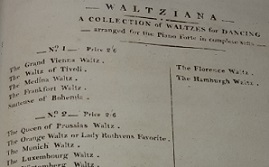
Figure 9. The contents of James Platts' first five numbers of the Waltziana (truncated); catalogue c.1817
James also published at least five volumes of his Waltziana in the 1810s. Each edition included several pages of waltz tunes, arranged for the Piano Forte by Platts. He advertised the third volume in 1814 (Morning Post, 5th December 1814), and the fourth volume in 1815 (Morning Post, 6th March 1815). The 5th volume was advertised within a Platts music catalogue issued in 1817 (see Figure 9), it was published at some point prior to that date. It's likely that these tunes were intended for use in waltz couple dancing, the popularity of which had been growing quite significantly since the visit to London of the allied monarchs in June 1814.
La Mêlange
One of James Platts most interesting and unusual works was also amongst his first. He registered his La Mêlange, or Longways for as Many as Will, or the New Medley with the proper figure for copyright purposes on the 2nd January 1792. A copy is available for study courtesy of Google Books (see Figure 10). I've no reason to think that the work was widely purchased, or that the dance was ever performed socially, but it is evidence of the almost unique approach to Country Dancing that James was considering. Even the subtitle of the dance implied that James was experimenting with the fundamental form of the Country Dance.

Figure 10. The unusual triple progression figures of James Platts' La Mêlange, 1791
The dance involves a medley of four separate tunes arranged in succession. He has 16 bars denoted as English in 2/4 measure, 16 Irish bars in 6/8 measure, 16 German bars in 3/8 measure, and 8 Scotch bars in common time. Each strain of music is repeated, for a total of 112 bars across the various time signatures. Medley tunes were nothing new, Scottish publications often arranged a Strathspey and Reel tune together; more complicated medleys were published such as (for example) the c.1805 Cottilion and Minuet tunes published in Edinburgh by Charles Stewart on behalf of the dancing master Mr Strange; Thomas Skillern had published his Caledonian Medley Dance in London in 1787. These publications either omitted dancing figures entirely, or applied a simple figure to the complicated music (Skillern, for example, had a 4 figure sequence danced to each of 12 tunes in succession). Platts however arranged a complicated multi-part figure that spanned the entire medley; moreover, Platts took the unusual approach of involving a triple progression, the sequence ends ... which brings you down 3 Cou. . Almost every figure sequence published at the time was single progression, an explicitly triple progression sequence is unique in my experience; it's convenient however, the next iteration of the medley can commence with a fresh minor set at the top of the longways set.
I've only encountered two other dances (with figures) like it before, both were in the 1764 Country Dancing Made Plain and Easy by A.D. Dancing Master . A.D. choreographed two dances for teaching purposes, they included just about every figure in his repertoire in succession; they weren't really intended for dancing to, they were probably more of an experiment. There's a final footnote to the Platts figures: This Tune may be danc'd with any single Figure . It's not entirely clear what James meant by single figure , I suspect he was using the same terminology that A.D. had used nearly 30 years earlier, it implied any figure that involves just two couples . In other words, you don't have to use this complicated triple progression figure sequence, use any simple figure (or combination of simple figures) you like .
We've animated a suggested arrangement of the dance in four parts: Part 1 (English), Part 2 (Irish), Part 3 (German), Part 4 (Scotch).
The dance is highly unusual, it's also obscure. James was perhaps hoping to reinventing the format of the Country Dance, there's no reason to think that the wider dancing industry took notice though. As far as I can tell he didn't repeat the experiment.
Spanish Dances
James, as we've already seen, was a keen promoter of the Tambourine towards the end of the 1790s; he was also an especially active promoter of the Castanuela or Spanish Castanets from 1804. Spanish themed dances were popular on both the London stage and (to a lesser extent) in British social dancing from around 1808 (see Figure 11), approximately concurrent with the start of the Peninsular War that was being fought in Portugal and Spain; James was ahead of the trend in promoting a Spanish style of dancing from as early as around 1804. Such dances as the Boleros, Cachucha, Guaracha and Zapateado were all of Spanish origin, they briefly flourished in London at a date before the Waltz and Quadrille had fully captured the public imagination. The defining characteristic (at least in the eyes of the British public) of the Spanish dances was the use of the castanets, an instrument for which James may have cornered the market in supplying. As with the Waltz, James had been promoting a new dance form before it became generally popular.
Edward Payne (one of the more successful dancing masters of the 1810s) promoted his own Spanish Country Dances from around 1815, he had perhaps benefited from a growing interest in Spanish themed dancing that had been fuelled by James for the previous decade. Later references to Spanish Dances sometimes refer to Payne's variant of the Country Dance, rather than to the castanet dances promoted by Platts (and others).
Country Dances
James and Martin published dozens of collections of Country Dances, they were active in doing so from the 1780s to the late 1810s. I've found James' collections published in the late 1790s to be of particular interest, they're almost Wilsonian in content (despite predating Thomas Wilson by a decade). We'll investigate some of the more interesting dance figures from the Platts collections shortly.
James began his series of popular and original country dances c.1807; the editions before number 10 were made up of already popular tunes, most of which were (probably) copied from the publications of Skillern & Challoner, together with a small selection of other sources. The copying was no mere accident; every note, accompaniment, dancing figure, and error, is identical. Almost every dance published by Skillern & Challoner between their c.1806 1st and c.1809 8th numbers appears within James' collections, albeit in a different sequence. The similarity is far greater than might normally be expected; if different publishers issued the same tune they'd usually offer a different accompaniment and dancing figures, they don't tend to be identical. That stated, it's difficult to prove who published first, the estimated publication dates for James' publications are a little speculative so there is the potential for confusion. Skillern & Challoner's 9th number included a copyright declaration asserting that their work was being copied and warning the public to beware (but without naming a culprit); this suggests that they knew James was copying their work, if so their warning had the desired effect as the copying ceased thereafter. A small number of James' tunes contain errors which are absent from the Skillern & Challoner versions, hinting at a copying error; for example, the B strain of The Honey Moon in James' 2nd number should change to a bass clef but doesn't. Moreover, several of James' dances that don't appear to originate with Skillern & Challoner can be tracked to other even earlier sources. James appeared to cease copying from his peers from his 1809 10th number onwards; his figures thereafter are quite different to those of the earlier publications, they revert to the style evident in his publications of the 1790s; there can be little real doubt that James was copying from Skillern & Challoner, even if it can't be proved with complete certainty. A few of the tunes in James' 11th number are (perhaps provocatively) named to match tunes in Skillern & Challoner's 8th and 9th numbers, but with different tunes and figures - this may have been a defiant gesture.

Figure 12. An 1817 Catalogue of James Platts' dances
James composed most of the tunes that he published in the 1790s (and in the 1810s from his 10th number forwards) himself. Some of his tunes achieved broad popularity, including such examples as Zoic's New Dash and Michael Wiggins; both of these tunes featured amongst James' counter-claims in his copyright disputes of the 1810s. Perhaps his best known tune today is his 1798 Dover Cliffs (which was presumably composed during his time in Dover). Thomas Wilson credited James as the source for some of the tunes in his own Treasures of Terpsichore publications for 1810 and 1811.
James issued four elegantly bound collections of his Country Dances (see figure 1), the last of which was probably published in 1816, each volume consisting of 12 of his separate monthly collections (in practice they weren't issued so much monthly as sporadically). The copies I've studied are careful to note the composers of each tune, at least from the 10th number forwards, the most prolific composer being James himself; James was unusual in crediting his composers this way, most publishers didn't bother to do so. Perhaps James felt the necessity to name his composers after being challenged for copying so much of Skillern & Challoner's repertoire.
Martin's dance collections were evidently published separately to those of James, they were issued through Clementi & Co. The content sometimes overlapped with that of James, but no more so than would be expected of any other two music publishers picked at random. I've struggled to locate copies of many of Martin's dance collections, those I have studied are somewhat interesting; they're broadly similar to those of James, but with some unusual figures. Martin's collections were issued with two different cover designs, an earlier variant and a later variant, perhaps hinting at two phases of production. Two different works are issued as number 7, it's possible that a numbering error of some kind occurred within the sequence. Martin probably issued his collections from the year 1812 onwards, perhaps after having witnessed James' success; we might speculate that customers would enter his shop asking for the most recent of Platts' collections (not realising that the two Platts music shops were separate), and Martin thereby identified an opportunity. Martin is likely to have continued publishing collections until the year of his death, 1817.
Aside: Martin published his dances through the firm of Clementi & Co. Clementi published his own set of perhaps 35 or more Numbers of his Periodical Collection of Popular Dances across the first couple of decades of the 19th century, a curious gap exists in Clementi's publishing sequence however. His 23rd Number was probably published in or around the year 1811, his 24th Number in 1817; this pause neatly matches the period in which Martin Platts was publishing through Clementi & Co.. Some of Clementi's earlier publications, including his c.1809 6th Number, explicitly credit Martin Platts as the arranger of the dances; some of the later numbers, such as the 18th Number, reuse content from earlier numbers (the 18th collection is a subset of the 6th). It's possible that that Clementi & Co ceased publishing their own series c.1812 because Martin Platts had decided to issue collections under his own name. Clementi & Co presumably resumed their series with their c.1817 24th Number following Martin's death.
Returning to James, his dancing figures of the 1790s generally fit his music, my impression is that he put some effort into arranging them to do so; they're less interesting than the Cahusac figures of a similar date, but they're broadly consistent. His figures from around 1809 to 1810 are similarly interesting, again they usually (with a few exceptions) fit the music. The figures of his c.1808 first 9 numbers are identical to those from the Skillern & Challoner collections, they are of a relatively low quality and often mismatch the music; they're noticeably different from his 1809-1810 repertoire. James' post 1808 figures improved in quality (though perhaps not in variety), though some still seem not to matched the music. This variation in quality is frustrating; he mixed long and short leading figures together from one dance to the next, regularly reused figure sequences, but also included some examples of genuine interest. This may of course be indicative of how little used published choreographies were amongst dancers two hundred years ago: the top-most couple in a dance were given the opportunity to call any figures they desired, the published figures might therefore be considered a suggestion rather than the proper figures . James' music was of a generally high quality, and he was clearly capable of arranging dancing figures to suit the music, but my impression is that he tended not to bother, especially after 1810. Perhaps a junior employee was given the task, and most figure sequences were copied from other tunes without consideration for whether they matched the music or not.
The Batteuse
One of the more exotic dances to appear in a Platts collection is a French Country Dance called La Batteuse; we've shared an entire paper on this dance before. Martin published one of the more detailed descriptions of this dance in his c.1816 10th Number. The music for the dance was arranged in distinctive 10 bar phrases, James also published a version (without figures) in his 1813 38th Number.
Quadrilles
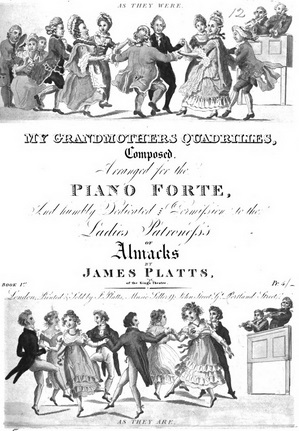
Figure 13. James Platts' 1820 My Grandmothers Quadrilles
The Quadrille dancing revolution that swept Britain from around 1816 came a little too late for the Platts. Martin died in 1817 and James is only known to have published a couple of Quadrille Sets. One set, his 1820 My Grandmother's Quadrilles (see Figure 13) are especially noteworthy; ironically their value is not so much in their content as in their cover! The artwork depicted two groups of dancers, one a group of cotillion dancers from around 1770 (As They Were ), and the other a group of Quadrille dancers from 1820 (As They Are ). The juxtaposed images implied a continuity in social dancing across fifty years and two generations, the veteran Cotillion dance was positioned as My Grandmother's Quadrille . The Platts, perhaps more than any other dance publishers of their generation, were entitled to make that claim - they had been active since the time of Francis Werner (one of the most prominent Cotillion publishers of the 1780s) through to 1820. The image implied that while costumes, music and steps may have evolved, the two dance forms were fundamentally linked. The publication was sufficiently popular to warrant a second edition being published in early 1821.
Country Dancing Figures and Dances of Note
What follows is a list of figures and dances selected from across the Platts collections that may be of special interest. As already noted, the quality of the Platts dances varies quite considerably over time, thereby casting doubt on the validity of the observations... if the timing is unusual that might imply an error in the source work rather than a unique new figure sequence. Many of the figure sequences recur many times over within the collections, this might imply that older favoured sequences were being reused without much consideration for how they fit the music, especially with the later collections.
Unusual music
Many of the Platts tunes are very well arranged musically, but a few are comment worthy for defying the normal conventions for country dances at the time.
There are numerous tunes with a mixture of time signatures, perhaps half the tune being in common time and half in waltz time, or similar; there are also percussive examples with a tambourine or castanet accompaniment to the main melody. A few of the tunes are arranged in an uncommon time signature, such as James' 1798 Old Laughlin and 1799 Fizgig which are printed in 6/4 measure. Some of the tunes have an unusual number of bars, such as the 6 bar strains in The Shamrock So Green from James' 1813 34th Number, and also his St Patricks Day in the Morning from the 1813 36th Number. The 1813 Battuese from James' 38th Number includes the familiar 10 bar arrangement for that particular dance, the c.1815 Caller Herring from his 45th Number is made up entirely of 6 bar strains. Some of the tunes switch key part way through, and James' entire collection is unusual for naming the composers of most of the tunes. Martin's collections also featured some oddities, including the 6 bar strains of his 1787 Which is the Man.
Leading figures
The leading figure is something we've discussed in previous papers; there are two major variations, one in long measure (typically 8 bars of music) and one in short measure (typically 4 bars of music, though the difference is not that simple). Dances of the 18th century usually feature the long lead, dances of the early 19th century often feature the short lead, especially if they were choreographed by Thomas Wilson. The 1790s through 1800s were a transitional period, both styles can be found even in the highest quality of publications.
James' country dances of the 1790s tend to feature a short lead, most often the instruction to lead down 2 Cu, and up one, typically arranged to a short strain of music. I think of this figure as a Wilsonian Lead, but perhaps I should refer to it as the Plattsian Lead given that the Platts publications predate Wilson's by a decade! The bulk of James' publications of the late '90s use this figure (for example the 1796 Jane of York), though some (such as the 1797 Killishandra) arrange it to a long measure of music.
James didn't use the short lead exclusively. For example, his 1796 Moll i'th Wad includes the figure lead down the middle, up again, cast off in a long measure arrangement. He also featured the double instruction Lead down the Middle 2 Cu & up again, Lead down the Middle 2 Cu & up one in such dances as the 1797 Hubble Bubble, and The 1st Lady lead the 2d Gent down the middle and up again, the 1st Gent do the same with the 2d Lady in such dances as Lady Mary Bentinck's Return from the c.1811 25th Number. An uncommon The 1st Cu lead down the middle the 2d follow, hands across half round then lead up again and hands across half round can be found in such dances as The Ghost of Michael Wiggins from the 1811 26th Number (see Figure 14), and the two Couples lead down the middle, up again can be found in Jean de Paris from the 1814 43rd Number. James' 1799 Elegant Simplicity included the elegantly simple instruction first cu lead down the middle one Cu and cast up into their own places, 2d Cu lead up and cast off one Cu .
The 1813 The Knight of Snowdown from the 35th Number includes the unusual use of a leading figure after the progression for the dance has already taken place; it could be argued that this dance features a double progression, though other explanations are more likely (such as an error in the figures, or the leading figure returning back to progressed position).
James' collections of the 1810s mix long and short leads indiscriminately; whether a dance is arranged to the short or long figure seems more a matter of chance than design (some of the sequences don't fit the music either way!).
Pousette figures
Martin's country dance collections are very similar to those of James, with one key difference - he routinely featured a figure he named the Swing Pousette . It's not clear to me what he meant by the term, but it features in many of his arrangements of the 1810s. I've not found this term in any of James' publications (or anywhere else). One possible interpretation of a Swing Pousette might be the figure better known today as the Draw Pousette - a figure in which one partner pulls the other around the edge of a circle such that they reach progressed positions improper, and then return to their original positions in the second half of the figure. The Swing Pousette often (but not always) follows a figure that appears to leave the two active couples progressed and improper, I've therefore tended to arrange it as a half draw pousette followed by a half regular pousette (see for example La Belle Annette from Martin's c.1816 10th Number). Such reconstructions are inevitably speculative.
James had his own pousette terminology, he used the phrase Pousette into proper places , for example in Michael Wiggins from the 1809 11th Number. My impression is that he used the expression to imply regardless of where the preceding figure ended, pousette into progressed position, either once around or one and a half times around ; it can be found after clearly progressive figures and after clearly non-progressive figures, it's generally followed by a clearly non-progressive figure. James also used the phrase Pousette quite round seemingly to mean the same thing, and even Pousette round to the 2d Cu place in at least one dance.
Chasing figures
Chasing figures are uncommon in early 19th century Country Dances, but James did use 1st Lady Cast off into the 2d Ladys place, her partner following, foot it, and cast up again in the 1796 Mrs Wardhums Fancy. The text is a little unclear, I think a simple chase-and-return figure is implied. A second chase variant can be found in The Jubilee Waltz from the c.1810 15th Number, it includes: The 1st Gent follows his parter round the next Cu, back again .
Casting figures
A few of the dances include an unusual progressive casting figure: Cast off 2 Cu and up 1, fall in . An example can be found in the c.1810 The Miller of Drone from the 10th Number.
Crossing figures

Figure 15. The figures to the 1810 The Bronti Waltz from the 21st Number; Image © THE BRITISH LIBRARY BOARD, h.726.m.(10.) ALL RIGHTS RESERVED.
An unusual Cross over 1 Cu and Hands 3 outsides figure can be found in James' c.1810 Deborah in a Wig from the 20th Number. The figure sequence requires the active couple to return to the top, so presumably the hands three is established while the active dancer is outside of the set, then released half way around so that the active dancer can get home. I've not encountered this figure variant anywhere else, it may have been a simple misprint.
Marching figures
A few of the dances feature an unusual marching figure arranged as a chain. For example James' 1810 The Bronti Waltz from the 21st Number has 8 bars of music set aside in common time (with a castanet accompaniment) for The 1st & 2d & 3d Cu March a la Chaine, to their own places . A footnote then explains the figure: La chaine is performed thus: The 3 Cu face the top then right & left quite round to their own Places, the Ladies following the 1st Lady, & the Gents following the 1st Gent (see Figure 15).
It's not entirely clear to me whether right and left quite round implied military marching, as in the marching figure Thomas Wilson described in his 1808 Analysis of Country Dancing; or whether it implied a chaining-the-set figure as seemingly implied by the title La Chaine (but arguably contradicted by James' instruction to face the top). Perhaps it was a hybrid figure involving elements of both. Either way, the Marching figure is followed by another figure in waltz time. Wilson documented two different marching figures for use within Country Dances; I've yet to find any example choreographies that explicitly used either of Wilson's figures, though the Platts Marching figure is a close match. It's possible that Wilson had documented a convention that Platts himself had invented, Marching within a country dance may have been largely unknown beyond Platts' own arrangements. A marching figure in which the dancers might use castanets to punctuate their steps must have been fun in the ballroom! A second example can be found in The Tarutino Waltz from the 1813 36th Number.
Forming a line
Several of the dances include a figure that involves forming a serpentine line across the top of the set, the typical instruction is: The 1st Gent turn his Partner half round with the right hand and take the 2d Lady with the left; still keeping his Partners hand, the 1st Lady at the same time takes the 2d Gent with the left hand and thus form a line; Sett and turn into proper places (for example in Earl Wellington in James' 1812 30th Number).
Several dances, including the 1812 The Hermitage from James' 31st Number, contain what is presumably the same figure but with minor changes; the word thus is printed as then , and the closing and turn is omitted such that the figure reads The 1st Gent turn his Partner half round with the right hand, and take the 2d Lady with left, (still keeping his Partners hand) the 1st Lady at the same time takes the 2d Gent with the left hand and then form a line, sett into proper places . It seems clear to me that this variant is intended to be the same as the first variant, but incorporates two errors; it's a clue that unusual figures elsewhere in Country Dancing may also be unintentional; an exotic phrase such as sett into proper places may have been intended as set and turn into proper places .
Swinging figures
A few of James' dances include a sequence of single-handed half turn figures: The 1st Cu turn half round with the right hand, 1st Lady turn the 2d Gent half round with the left hand and back again with the right; 1st Gent do the same with 2d Lady at the same time, turn into proper places with the left hand (for example in the 1813 Lady Wellington in the 35th Number). Martin used the same figure in Johnny's A Coming from his c.1813 7th Number.
Martin also featured an unusual figure in Le Diable from his 1791 23rd Book: The 1st Gent swing his partner half round with the left hand & cast off one Cu; the same with the right & cast up ; the more common variant of this figure is for the lead couple to swing entirely around and then cast, typically starting with the right hand. He also arranged such combinations as The 1st Gent Swing his Partner half round and Allemand with the 2d Lady at the same time the Lady Allemands with the 2d Gent; Swing half Round back again as can be found (for example) in the 1798 Miss Emily Conways Waltz, and The 1st Couple allemand half round with the right hand, the 1st Gent turn the 2d Lady half round with left hand & back again with the right, at the same time the 1st Lady repeats the same figure with the 2d Gent, the 1st couple half allemand with the left hand to their own places in The Batteuse Country Dance from his c.1816 10th Number.
Lead and Set Outsides figures

Figure 16. Orange Boven! from James Platts' c.1814 40th Number; Image © THE BRITISH LIBRARY BOARD, h.726.m.(10.) ALL RIGHTS RESERVED
The collection of figures variously referred to as Lead Outsides are infamously tricky to interpret. We've offered observations on the figure from the Cahusac dance collections in a previous paper. The Platts collections also include some interesting terminology, including:
Foot it outsides , as in James' 1796 The Princess of Wales's Waltz.
The 1st Lady go between the 2d & 3d Gent, the 1st Gent go between the 2d & 3d Ladies, sett outsides back again , as in James' 1809 The Rocket (from the 12th Number).
1st Lady go between the 2d & 3d Gent, at the same time her partner goes between the 2d & 3d Ladies; set outsides then turn & set inside , as in James' c.1810 Miss Binghams Fancy (from the 22nd Number).
First Lady fall in between 2d & 3d Gent, at the same time 1st Gent falls in between 2d & 3d Lady, foot it out on opposite sides, meet again & foot it , as in James' c.1810 Le Diable Boiteaux (from the 23rd Number).
First Lady goes between 2d & 3d Gent, foot outsides, the 1st Gent at the same time lead out the 2d & 3d Ladies, back again , as in James' c.1810 The Bridal Ring (from the 24th Number).
lead out sides & turn your Partner with both hands , as in James' c.1811 Mony Musk (from the 25th Number).
1st Lady fall in between 2d & 3d Gents, at the same time the 1st Gent goes between the 2d & 3d Ladies, foot out on opposite sides, back again, turn into proper places , as in James' c.1816 Miss Wentworths Favorite (from the 47th Number).
Many of these variants are clearly related, perhaps they're intended to be identical. In most examples the active couple start at the top of the set, the lead outsides either provides the progression, or is followed by another figure that can provide the progression.
Feature Dances
A handful of the dances stand out as being special, in most cases they're known from other collections. Examples include:
There are many other interesting dances of course, but these few are especially interesting for defying the normal conventions of the country dance.
The Platts' Dance Publications
The following table lists the Platts Dance publications that I've studied. Most of them are not currently available on the web (links are provided where possible); other titles are likely to have existed, but surviving copies have eluded my attempts at discovery. If you are lucky enough to own copies of any of these works, do please consider sharing them with the community of enthusiasts who enjoy recreating these dances. If you'd like assistance in so doing, please do Contact Us.
| Work & Date | Image | Comments |
Book XX for the Year 1787, Eight Cotillions, 6 Country Dances and two Minuets
Martin Platts |
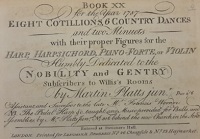
|
The contents are: La belle Annette, La Bergerette, L'Aurore, Les Plaisier de Montreil, L' d'Amour, La Figaro, L'Oursine, La Simplice, The 19th of January, The Pleasures of Dorking, Captain Mackintosh, A trip to Bookham, The Rein Deer, Which is the Man, Sir John Henderson's Minuett, Miss Hotchkin's Minuett.
Full Title: Book XX for the Year 1787, Eight Cotillions, 6 Country Dances and two Minuets, with their proper Figures for the Harp, Harpsichord, Piano-Forte, or Violin. Humbly Dedicated to the Nobility and Gentry Subscribers to Willis's Rooms, by Martin Platts Junr
Image © THE BRITISH LIBRARY BOARD, b.53.(4.) ALL RIGHTS RESERVED
|
Book the 20th for the Year 1787, Twelve New Country Dances
Martin Platts |
|
This book may be the otherwise lost 21st book, it was registered for copyright purposes on the 11th July 1787.
Full Title: Book the 20th for the Year 1787, Twelve New Country Dances with their proper figures for the Violin, Harp or Harpsichord. As performed at the Prince of Wales's, Willis's Rooms, Festino, etc. By Martin Platts, Jr.
|
Book XXII for the Year 1788, Eight Cotillions & Six Country Dances
Martin Platts |
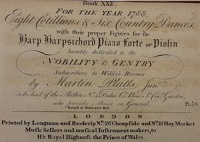
|
The contents are: La Faforitte, La Lesgere, La Bell Amazone, La Taison Dor..., La Bell Guimore, La Nina, La Ballarde, La Sagataire, The Belles of Walthamstow, Captain Mackdonld, Morgan Ratler, The 10th of January, La Visite, The Highlander.
Full Title: Book XXII for the Year 1788, Eight Cotillions & Six Country Dances, with their proper Figures for the Harp, Harpsichord, Piano-Forte, or Violin. Humbly dedicated to the Nobility & Gentry Subscribers to Willis's Rooms, by Martin Platts Junr
Image © THE BRITISH LIBRARY BOARD, b.52.(6.) ALL RIGHTS RESERVED
|
Book XXIII for the Year 1791, Six Cotillons and Twelve Country Dances
Martin Platts |
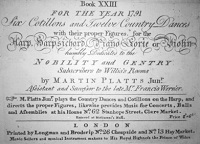
|
The contents are: Cà irà, La Petite Savoyards, La Galopade, La Jeune Payisan, Le Grand Fetre, La Susanne Aimable, The Camp of Pleasure, La Belle Fille, Patrick O row, Le Diable, Une Jolie Waltz, The Mask'd Ball, The Morning Rout, Trip to Brighton, The Peerage, Miss Worsly's Fancy, St. James's Day, Lewes Races.
Full Title: Book XXIII for the Year 1791, Six Cotillons and Twelve Country Dances, with their proper Figures. for the Harp, Harpsichord, Piano-Forte, or Violin. Humbly Dedicated to the Nobility & Gentry Subscribers to Willis's Rooms, by Martin Platts Junr. Assistant and Successor to the late Mr Francis Werner.
|
Four Favourite Waltz's
1791
James Platts |
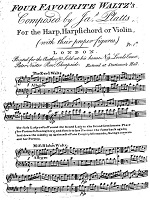
|
The contents are: The Ewel Waltz, Miss Blake's Waltz, The Prince's Waltz, La Petite Waltz.
Full Title: Four Favourite Waltz's Composed by James Platts, for the Harp, Harpsichord or Violin (with their proper figures).
|
La Mêlange, or Longways for as Many as Will
1791
James Platts |
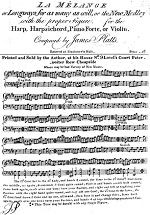
|
The contents are: La Mêlange.
Full Title: La Mêlange, or Longways for as Many as Will, or the New Medley, with the proper figure, for the Harp, Harpsichord, Piano Forte, or Violin. Composed by James Platts.
|
Four New Schleifers or Waltzers for 1792
James Platts |
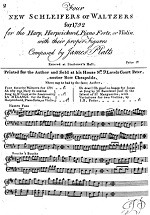
|
The contents are: Haasen Fuzz, Bouche à Bouche, Die Weiber Jagt, Die Lustbarkeit.
Full Title: Four New Schleifers or Waltzers for 1792, for the Harp, Harpsichord, Piano Forte, or Violin; with their proper Figures, Composed by James Platts.
|
Book 1st for the Year 1796, Twelve New Country Dances
James Platts |
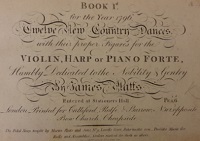
|
The contents are: The 28th of June, The Princess of Wales's Reel, Miss Wards Waltz, Moll i'th Wad, Badenock Rant, Jane of York, The Princess of Wales's Waltz, Mr Warringtons Reel, Bally Croy, Mrs Wardhums Fancy, The London Reel, Trip to Chelmsford.
Full Title: Book 1st for the Year 1796, Twelve New Country Dances, with their proper Figures for the Violin, Harp or Piano Forte, Humbly Dedicated to the Nobility & Gentry, by James Platts.
Image © THE BRITISH LIBRARY BOARD, a.11. ALL RIGHTS RESERVED
|
Book 2nd for the Year 1797, Twelve New Country Dances
James Platts |
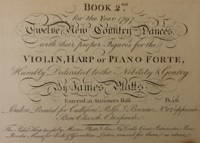
|
The contents are: Trip to Bognor, Carnsallack (A Strathspey), Tarbet Loch, Zoic's new Dash, Hubble Bubble, Killishandra, Chichester Bells, Miss Colt's Waltz, Dunrobin (A Strathspey), Trip to Kelso, Ling Besom, Finlarig Rant.
Full Title: Book 2nd for the Year 1797, Twelve New Country Dances, with their proper Figures for the Violin, Harp or Piano Forte, Humbly Dedicated to the Nobility & Gentry, by James Platts.
Image © THE BRITISH LIBRARY BOARD, a.11. ALL RIGHTS RESERVED
|
Book 3rd, Twelve New Country Dances, For the Year 1798
James Platts |
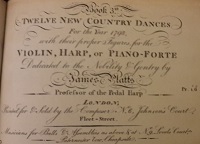
|
The contents are: Drops of Water, The Devil's a queer Pig, Zoics 2d Dash, Wheelbarrow Hall, Mrs Ellis's Waltz, Smiths Folly, Twee Twor, Zoic's Hornpipe, Dover Cliffs, Old Laughlin, Knock Dolin (A Strathspey),
Augusta's Favorite.
Full Title: Book 3rd, Twelve New Country Dances, For the Year 1798, with their proper Figures for the Violin, Harp or Piano Forte. Dedicated to the Nobility & Gentry, by James Platts, Professor of the Pedal Harp.
Image © THE BRITISH LIBRARY BOARD, a.11. ALL RIGHTS RESERVED
|
Book 25 for the Year 1798, of Strathspeys, Reels, Waltzs & Irish Jiggs
Martin Platts |
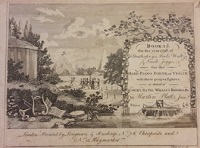
|
The contents are: Go to the Devil and Shake Yourself, Come from the Devil and Shake Yourself, The Devil's Dream, Captn Mackingtosh's Strathspey, Will You Come Plank come Plank (The favorite Irish Dance), Baltioura, The New Storace, Miss Webster's Waltz, Old Sr Simon the King, Miss Emily Conways Waltz, The Russian's Rant, Cameron Has Got His Wife Again, Miss Mackenzie's Reel, The Irish Frolick, Braes of Balquhedar, The Irish Jig, Lenox Love to Blantye, Fantocini, Hey my Nancy, The Bucks of Westmeath, Moll ith' Wad, Richers Hornpipe, Miss Blards Fancy, All at Home, The Rakes of Westmeath, The Parks of Kilbirnie, Philly McCue, Globe Waltz.
Full Title: Book 25 for the Year 1798, of Strathspeys, Reels, Waltzs & Irish Jiggs for the Harp, Piano Forte or Violin; with their proper figures as danced at Court, Bath, Willis's Rooms, &c. by Martin Platts Junr
Image © THE BRITISH LIBRARY BOARD, b.55.(1.) ALL RIGHTS RESERVED
|
Book 4th, Twelve New Country Dances, For the Year 1799
James Platts |
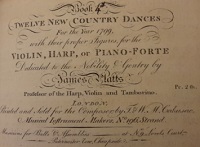
|
Note that these dances contain an accompaniment for the Tambourine.
The contents are: The Dasher, The Pretty Antoinette, Devil and no Devil, Zoics Third Dash, Fizgig, The Mull of Galloway, Nelson's Return, Trip to Louh Earn, Elegant Simplicity, A Trip to Howlets, The Brae Lads of Anandale (A Strathspey), Marian's Waltz.
Full Title: Book 4th, Twelve New Country Dances, For the Year 1799, with their proper Figures for the Violin, Harp or Piano Forte. Dedicated to the Nobility & Gentry, by James Platts, Professor of the Harp, Violin and Tamborino.
Image © THE BRITISH LIBRARY BOARD, a.11. ALL RIGHTS RESERVED
|
#1 Platts's Popular & Original Dances
c.1807
James Platts |
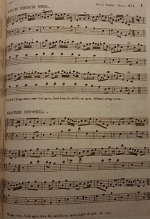
|
The tunes named Delvin Side and Noorah Creenah appears to have been copied verbatim from William Campbell's c.1800 15th Book. The music for Loch Erroch Side is a precise duplicate of that in the c.1806 Walker's Collection of Dances, No 8, though Walker did not print any dance figures. It's likely that all of the contents are copied from elsewhere.
The contents are: Loch Eroch Side, Master Setwell, Delvin Side, Lord Nelson's Waltz, Off She Goes, Noorah Creenah, Lady Mary Bentinck's Fancy.
Full Title: 1 Platts's Popular & Original Dances, for the Piano Forte, Violin, &c.; with proper figures.
Image © THE BRITISH LIBRARY BOARD, h.726.m.(10.) ALL RIGHTS RESERVED
|
#2 Platts's Popular & Original Dances
c.1807
James Platts |
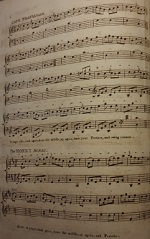
|
Some of the contents of this publication appear to have been copied/selected from the works of Skillern & Challoner. The dance named Dusty Miller appears to have been copied verbatim from William Campbell's c.1796 11th Book.
The contents are: Cape Trafalgar (see c.1806 S&C02), The Honey Moon (see c.1806 S&C01), Bognor Rocks (see c.1806 S&C01), Foley House (see c.1807 S&C04), Dusty Miller, Lord Mackdonald.
Full Title: 2 Platts's Popular & Original Dances, for the Piano Forte, Violin, &c.; with proper figures.
Image © THE BRITISH LIBRARY BOARD, h.726.m.(10.) ALL RIGHTS RESERVED
|
#3 Platts's Popular & Original Dances
c.1807
James Platts |
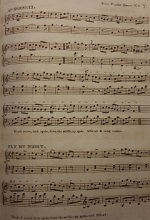
|
Some of the contents of this publication appear to have been copied/selected from the works of Skillern & Challoner. The tune named Devil in Denmark appears to have been copied verbatim from the c.1803 No. 2; Dale's Collection of Reels and Dances; the tune named Niel Gow is well known from other collections of a slightly earlier date, but I can't find a direct source. Several tunes circulated under the name Paddy O'Rafferty.
The contents are: Ap Shenkin (see c.1807 S&C04), Fly by Night (see c.1807 S&C04), Tekeli (see c.1807 S&C04), Paddy O'Rafferty, St Kildare (see c.1806 S&C03), Devil in Denmark, Niel Gow.
Full Title: 3 Platts's Popular & Original Dances, for the Piano Forte, Violin, &c.; with proper figures.
Image © THE BRITISH LIBRARY BOARD, h.726.m.(10.) ALL RIGHTS RESERVED
|
#4 Platts's Popular & Original Dances
c.1808
James Platts |
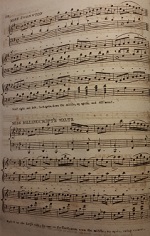
|
Much of the contents of this publication appear to have been copied/selected from the works of Skillern & Challoner. The tune named Miss Billingcroft's Waltz is known from other collections of a slightly earlier date, but it's not copied directly from any other versions I know of; the tune named The Carysport is not one I can associate with any other collections.
The contents are: Miss Johnston (see c.1806 S&C02), Miss Billingcroft's Waltz, The Carysport, The Travellers (see c.1806 S&C03), Lady Clementina (see c.1806 S&C03), Lord Grantham's Whim (see c.1806 S&C02).
Full Title: 4 Platts's Popular & Original Dances, for the Piano Forte, Violin, &c.; with proper figures.
Image © THE BRITISH LIBRARY BOARD, h.726.m.(10.) ALL RIGHTS RESERVED
|
#5 Platts's Popular & Original Dances
c.1808
James Platts |
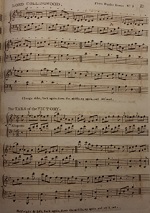
|
Most of the contents of this publication appear to have been copied/selected from the works of Skillern & Challoner. The tune named The Duchess of Bedford's Waltz has the same name as a Skillern & Challoner dance, but the tune and figure are different; many tunes with this name did exist at around the same date, I've not found any earlier source for this specific version.
The contents are: Lord Collingwood (see c.1806 S&C01), The Tars of the Victory (see c.1806 S&C03), The Bedford Jig (see c.1806 S&C01), Lord Nelson's Victory (see c.1806 S&C02), Lady Montgomery (see c.1806 S&C02), The Duchess of Bedford's Waltz
Full Title: 5 Platts's Popular & Original Dances, for the Piano Forte, Violin, &c.; with proper figures.
Image © THE BRITISH LIBRARY BOARD, h.726.m.(10.) ALL RIGHTS RESERVED
|
#6 Platts's Popular & Original Dances
c.1808
James Platts |
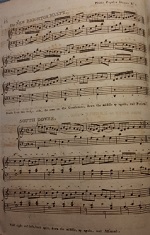
|
Most of the contents of this publication appear to have been copied/selected from the works of Skillern & Challoner; The New Brighton Waltz may be an original composition though the figures appear to have been selected from the similarly named The Brighton Waltz in Skillern & Challoner's c.1808 6th collection.
The contents are: The New Brighton Waltz, South Downs (see c.1808 S&C06), Miss Parkinson's Strathspey (see c.1808 S&C07), Miss Boyn or Knowle Park (see c.1807 S&C04), Paddy O'Connor (see c.1808 S&C06), Ride a Mile (see c.1808 S&C07), The Emperor of Hayti or King of the Catties (see c.1808 S&C06).
Full Title: 6 Platts's Popular & Original Dances, for the Piano Forte, Violin, &c.; with proper figures.
Image © THE BRITISH LIBRARY BOARD, h.726.m.(10.) ALL RIGHTS RESERVED
|
#7 Platts's Popular & Original Dances
c.1808
James Platts |
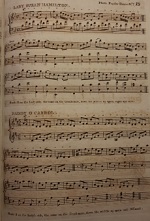
|
The contents of this publication appear to have been copied/selected from the works of Skillern & Challoner.
The contents are: Lady Susan Hamilton (see c.1806 S&C01), Paddy O Carrol (see c.1807 S&C04), Caro Dolce (see c.1806 S&C01), Love & Whiskey (see c.1806 S&C01), Mother Goose (see c.1807 S&C04), Lord Moira's Welcome to Scotland (see c.1806 S&C02).
Full Title: 7 Platts's Popular & Original Dances, for the Piano Forte, Violin, &c.; with proper figures.
Image © THE BRITISH LIBRARY BOARD, h.726.m.(10.) ALL RIGHTS RESERVED
|
#8 Platts's Popular & Original Dances
c.1809
James Platts |

|
The contents of this publication appear to have been copied/selected from the works of Skillern & Challoner.
The contents are: Kinloch of Kinloch (see c.1808 S&C07), Calabria (see c.1809 S&C08), The Wolds of Sussex (see c.1808 S&C07), The Nameless (see c.1807 S&C05), The Labyrinth (see c.1807 S&C05), The Fairy Dance (see c.1807 S&C05), Sir Richard Strachan or the Wapping Assembly (see c.1807 S&C05), Tommy Pringle (see c.1807 S&C05).
Full Title: 8 Platts's Popular & Original Dances, for the Piano Forte, Violin, &c.; with proper figures.
Image © THE BRITISH LIBRARY BOARD, h.726.m.(10.) ALL RIGHTS RESERVED
|
#9 Platts's Popular & Original Dances
c.1809
James Platts |
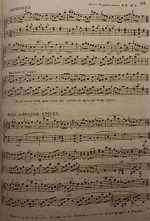
|
James mentioned the existence of this collection in an advertisement in the Morning Post newspaper for 1st March 1809.
The contents of this publication appear to have been copied/selected from the works of Skillern & Challoner.
The contents are: Morgiana (see c.1809 S&C08), Miss or Major Spicer (see c.1808 S&C07), Miss Ray or Shaddie (see c.1807 S&C05), New Claret (see c.1808 S&C06), The Runaway (see c.1808 S&C07), Lord Cathcart (see c.1809 S&C08), Captain Fleming (see c.1808 S&C07), Prime of Life (see c.1809 S&C08).
Full Title: 9 Platts's Popular & Original Dances, for the Piano Forte, Violin, &c.; with proper figures.
Image © THE BRITISH LIBRARY BOARD, h.726.m.(10.) ALL RIGHTS RESERVED
|
#10 Platts's Popular & Original Dances
1809
James Platts |
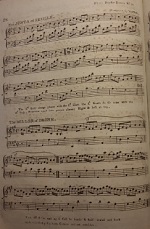
|
James advertised in the Morning Post newspaper for 1st March 1809 that On Monday next will be published, price 1s, No 10, of Platts's Popular and Original Dances .
One of the tunes in this collection (Prince Dolgorucki) was credited amongst the source music for Thomas Wilson's Treasures of Terpsichore for 1810. Sir John Moore died in early 1809, the tune called The Triump is better known as The Triumph.
The contents are: The Junta of Seville (J Platts), The Miller of Drone, Sir John Moore's Reel (J Platts), The Ridicule, Crackenberg Castle (J Platts), The Triump, Prince Dolgorucki (A Russian Dance).
Full Title: 10 Platts's Popular & Original Dances, for the Piano Forte, Violin, &c.; with proper figures.
Image © THE BRITISH LIBRARY BOARD, h.726.m.(10.) ALL RIGHTS RESERVED
|
#11 Platts's Popular & Original Dances
1809
James Platts |
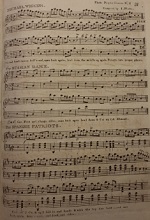
|
Testimony in one of James Platts' copyright disputes of 1815 reveal that James composed Michael Wiggins in 1809. James advertised in the Morning Post newspaper for 2nd May 1809 that The celebrated Dance of Michael Wiggins is published in No 11, of Platt's Popular Dances , it was also published by music shops across London at a similar date. The tune called The Russian Dance is also known as The Opera Hat.
The contents are: Michael Wiggins (J Platts), The Russian Dance, The Spanish Patriots, Spanish Patriot, Flights of Fancy (J Platts), The Exile, Lady Caroline Lee.
Full Title: 11 Platts's Popular & Original Dances, for the Piano Forte, Violin, &c.; with proper figures.
Image © THE BRITISH LIBRARY BOARD, h.726.m.(10.) ALL RIGHTS RESERVED
|
#12 Platts's Popular & Original Dances
1809
James Platts |
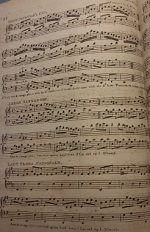
|
James advertised in the Morning Post newspaper for 2nd May 1809 that No 12 will be published on Monday next .
One of the tunes in this collection (Madam Angiolini) was credited amongst the source music for Thomas Wilson's Treasures of Terpsichore for 1810. The Princess of Wales's Waltz is reprinted from James' 1796 Book 1st.
The contents are: Whittington's Cat (J Platts), Baron Altradorf, Lady Flora Macdonald, Madam Angiolini (J Platts), The Rocket (J Platts), Flodden Field (J Platts), The Princess of Wales's Waltz (J Platts), Basque Roads (J Platts).
Full Title: 12 Platts's Popular & Original Dances, for the Piano Forte, Violin, &c.; with proper figures.
Image © THE BRITISH LIBRARY BOARD, h.726.m.(10.) ALL RIGHTS RESERVED
|
#13 Platts's Popular & Original Dances
c.1809
James Platts |

|
Testimony in one of James Platts' copyright disputes of 1815 reveal that James purchased Ferne Hill from Lady Ashbrook in 1809. This collection was registered for copyright purposes at Stationer's Hall in late 1810, along with numbers 14 and 15 in the series. I have no explanation for why that registration came so late.
One of the tunes in this collection (Morgiana in Ireland) was credited amongst the source music for Thomas Wilson's Treasures of Terpsichore for 1810.
The contents are: Morgiana in Ireland, The Sylph, Ferne Hill (Property), The Gnome or Blue Sprite (J Platts), Miss Metcalfe's Waltz (Property), Terifico! (Property), Mrs George Wilson's Reel (Property).
Full Title: 13 Platts's Popular & Original Dances, for the Piano Forte, Violin, &c.; with proper figures.
Image © THE BRITISH LIBRARY BOARD, h.726.m.(10.) ALL RIGHTS RESERVED
|
#14 Platts's Popular & Original Dances
c.1809
James Platts |
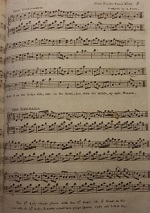
|
Testimony in one of James Platts' copyright disputes of 1815 reveal that James purchased Himley Park from Henry Nicholson in 1809. This collection was registered for copyright purposes at Stationer's Hall in late 1810, along with numbers 13 and 15 in the series. I have no explanation for why that registration came so late.
Two of the tunes in this collection (The Barbara and Himley Park) were credited as source material for Thomas Wilson's Treasures of Terpsichore for 1810. Zoic's new Dash is reprinted from James' 1797 Book 2nd.
The contents are: The Gossamer (J Platts), The Barbara, Himley Park (Nicholson), The Zodiac, or Zoic's new Dash (J Platts), Ashthorpe Park (J Platts), The Trifler (J Platts), Miss Palmer's Reel.
Full Title: 14 Platts's Popular & Original Dances, for the Piano Forte, Violin, &c.; with proper figures.
Image © THE BRITISH LIBRARY BOARD, h.726.m.(10.) ALL RIGHTS RESERVED
|
#15 Platts's Popular & Original Dances
1810
James Platts |
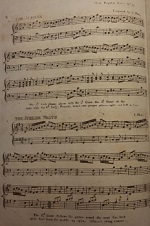
|
This Jubilee themed collection of dances presumably marked George III's 50th year as monarch. It was registered for copyright purposes on the 7th December 1810 (along with numbers 13 and 14 of the series); I have no good explanation for why it was registered so late, or why more recent numbers from the series were not also registered at that same date.
The contents are: The Jubilee (J Platts), The Jubilee Waltz (J Platts), A Trip to Windsor (J Platts), The Commemoration (J Platts), The Accession (J Platts), The Anniversary (J Platts), King and Constitution (J Platts).
Full Title: 15 Platts's Popular & Original Dances, for the Piano Forte, Violin, &c.; with proper figures.
Image © THE BRITISH LIBRARY BOARD, h.726.m.(10.) ALL RIGHTS RESERVED
|
#16 Platts's Popular & Original Dances
1810
James Platts |
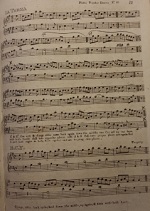
|
The La Terza dance was popular in 1810, the O.P. was a name given to numerous tunes in reference to the O.P. Riots of September 1809. The initials B.C.Y. probably refer to the political slogan Burdett Calls You from April 1810.
The contents are: La Terza, B.C.Y. (Property), Gilston Park (J Platts), Woodstock Bower (J Cookman), The Jubilee in Ireland, O.P., Crop the Croppies.
Full Title: 16 Platts's Popular & Original Dances, for the Piano Forte, Violin, &c.; with proper figures.
Image © THE BRITISH LIBRARY BOARD, h.726.m.(10.) ALL RIGHTS RESERVED
|
#17 Platts's Popular & Original Dances
1810
James Platts |
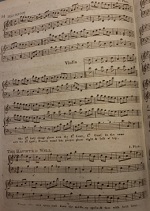
|
One of the tunes is called The Haunted Well, it was a pantomime popular at Covent Garden in early 1810. The Mamprina tune was very popular c.1809, it was variously known as The Italian Dance , The Sicillian Dance , The Momferina , The Momfrina , The Monferrina , The Manfreda and other similar variations.
The contents are: Marmion (J Platts), The Haunted Well (J Platts), Miss Hervey's Waltz (Property), Mamprina or Sicilian Dance, The Union Hornpipe (Property), Cinquanti è Piu (J Platts).
Full Title: 17 Platts's Popular & Original Dances, for the Piano Forte, Violin, &c.; with proper figures.
Image © THE BRITISH LIBRARY BOARD, h.726.m.(10.) ALL RIGHTS RESERVED
|
Platts's Popular & Original Dances, Book 1st
1810
James Platts |
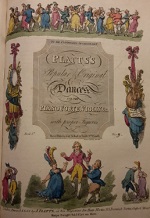
|
This volume collects together the first 12 numbers of James's collections. It was advertised in the Morning Post newspaper for 29th June 1810. He evidently aspired to create a second such volume soon afterwards, he probably had five numbers in hand ready and he hurried a further four to press in quick succession.
Full Title: Book 1st, Platts's Popular & Original Dances, for the Piano Forte, Violin, &c.; with proper figures.
Image © THE BRITISH LIBRARY BOARD, h.726.m.(10.) ALL RIGHTS RESERVED
|
#18 Platts's Popular & Original Dances
1810
James Platts |
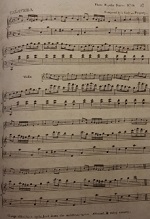
|
Platts advertised in the Morning Post newspaper for 29th June 1810 that Nos 18, 19, and 20 of Platts's Popular Dances are now ready for delivery, price 1s each .
The contents are: Talavera (a Lady, Property), Villa Diego (J Platts), La Montanverd (J Platts), Miss Powis's Fancy (Property), La Debonaire (a Lady, Property), The Union Jig (H. Nicholson, Property).
Full Title: 18 Platts's Popular & Original Dances, for the Piano Forte, Violin, &c.; with proper figures.
Image © THE BRITISH LIBRARY BOARD, h.726.m.(10.) ALL RIGHTS RESERVED
|
#19 Platts's Popular & Original Dances
1810
James Platts |
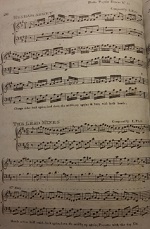
|
Platts advertised in the Morning Post newspaper for 29th June 1810 that Nos 18, 19, and 20 of Platts's Popular Dances are now ready for delivery, price 1s each .
The contents are: Hexham Abbey (J Platts), The Lead Mines (J Platts), A Trip to the Tower (J Platts), Allenheads (J Platts), Sleepy Moggy, The Little Perssee (J Platts), The Persian Dance.
Full Title: 19 Platts's Popular & Original Dances, for the Piano Forte, Violin, &c.; with proper figures.
Image © THE BRITISH LIBRARY BOARD, h.726.m.(10.) ALL RIGHTS RESERVED
|
#20 Platts's Popular & Original Dances
1810
James Platts |
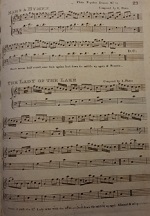
|
Platts advertised in the Morning Post newspaper for 29th June 1810 that Nos 18, 19, and 20 of Platts's Popular Dances are now ready for delivery, price 1s each .
The contents are: Mars & Hymen (J Platts), The Lady of the Lake (J Platts), The Border Minstrel (J Platts), O'er Bogie to my Love, The Village Doctor (J Platts), Deborah in a Wig (Property).
Full Title: 20 Platts's Popular & Original Dances, for the Piano Forte, Violin, &c.; with proper figures.
Image © THE BRITISH LIBRARY BOARD, h.726.m.(10.) ALL RIGHTS RESERVED
|
#21 Platts's Popular & Original Dances
1810
James Platts |
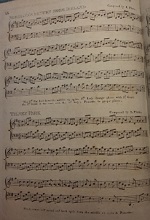
|
Platts advertised in the Morning Post newspaper for 29th June 1810 that this collection would be published in a few days .
The contents are: Morgiana's Return from Ireland (J Platts), Tilney Park (J Platts), Culver (or Beaumont) Lodge, Baron Crackenburg (Property), The Bronti Waltz (Platts).
Full Title: 21 Platts's Popular & Original Dances, for the Piano Forte, Violin, &c.; with proper figures.
Image © THE BRITISH LIBRARY BOARD, h.726.m.(10.) ALL RIGHTS RESERVED
|
#22 Platts's Popular & Original Dances
c.1810
James Platts |
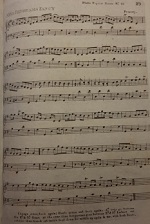
|
The contents are: Miss Bingham's Fancy (Property), Platts Medley containing:
Full Title: 22 Platts's Popular & Original Dances, for the Piano Forte, Violin, &c.; with proper figures.
Image © THE BRITISH LIBRARY BOARD, h.726.m.(10.) ALL RIGHTS RESERVED
|
#23 Platts's Popular & Original Dances
c.1810
James Platts |
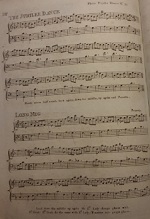
|
The contents are: The Jubilee Dance, Long Meg (Property), Lord Wellington (J Platts), Fidgetina's Waltz (J Platts), Le Diable Boiteaux, Draycot Lodge (J Platts).
Full Title: 23 Platts's Popular & Original Dances, for the Piano Forte, Violin, &c.; with proper figures.
Image © THE BRITISH LIBRARY BOARD, h.726.m.(10.) ALL RIGHTS RESERVED
|
#24 Platts's Popular & Original Dances
c.1810
James Platts |
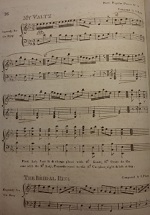
|
The contents are: My Waltz (J Platts), The Bridal Ring (J Platts), Capo Volto (J Platts), The Three and the Deuce, Calto Hill, Miss Melville.
Full Title: 24 Platts's Popular & Original Dances, for the Piano Forte, Violin, &c.; with proper figures.
Image © THE BRITISH LIBRARY BOARD, h.726.m.(10.) ALL RIGHTS RESERVED
|
#25 Platts's Popular & Original Dances
c.1811
James Platts |

|
One of the tunes is called The Magic Pipe, it's probably a reference to the comic pantomime of the same name performed at the Sans Pareil Theatre from December 1810.
The contents are: Gustavus, The Sweden Waltz, Mony Musk, Lady Mary Bentinck's Return, The Magic Pipe, Sir Roger De Coverley.
Full Title: 25 Platts's Popular & Original Dances, for the Piano Forte, Violin, &c.; with proper figures.
Image © THE BRITISH LIBRARY BOARD, h.726.m.(10.) ALL RIGHTS RESERVED
|
Platts's Popular & Original Dances, Book 2nd
1811
James Platts |
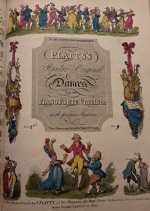
|
This volume collects together numbers 13 through 24 of James's collections. It was advertised in the Morning Post newspaper for 23rd January 1811.
Full Title: Book 2nd, Platts's Popular & Original Dances, for the Piano Forte, Violin, &c.; with proper figures.
Image © THE BRITISH LIBRARY BOARD, h.726.m.(10.) ALL RIGHTS RESERVED
|
#26 Platts's Popular & Original Dances
1811
James Platts |
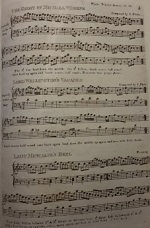
|
Platts advertised this collection in the Morning Post for 23rd January 1811.
The contents are: The Ghost of Michael Wiggins (J Platts), Lord Wellington's Vagaries (J Platts), Lady Metcalfe's Reel (Property), Elmore Lands (J Platts), The Giraffe (J Platts), Dorothea (J Platts).
Full Title: 26 Platts's Popular & Original Dances, for the Piano Forte, Violin, &c.; with proper figures.
Image © THE BRITISH LIBRARY BOARD, h.726.m.(10.) ALL RIGHTS RESERVED
|
#27 Platts's Popular & Original Dances
1811
James Platts |
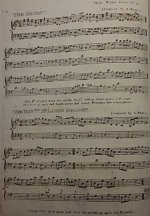
|
Platts advertised this collection in the Morning Post for 23rd January 1811, together with an intention to publish a further such number each month thereafter.
The contents are: The Regent (J Platts), The Honble Mr Lamb's Delight (J Platts), The New Persian Dance (J Platts), Miss Cooper's Hornpipe (Property), Heads Hornpipe (Property), Ourselves (J Platts).
Full Title: 27 Platts's Popular & Original Dances, for the Piano Forte, Violin, &c.; with proper figures.
Image © THE BRITISH LIBRARY BOARD, h.726.m.(10.) ALL RIGHTS RESERVED
|
#28 Platts's Popular & Original Dances
1811
James Platts |
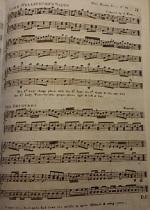
|
The reference to General Beresford probably dates this collection to 1811.
The contents are: Lord Wellington's Waltz (J Platts), The Recovery (Property), Twickenham Meadows (J Platts), Three in a Curricle (J Platts), General Beresford (J Platts), The Pic Nic Dance (Property).
Full Title: 28 Platts's Popular & Original Dances, for the Piano Forte, Violin, &c.; with proper figures.
Image © THE BRITISH LIBRARY BOARD, h.726.m.(10.) ALL RIGHTS RESERVED
|
#29 Platts's Popular & Original Dances
c.1811
James Platts |

|
Two of the tunes are named for the great comet of 1811.
The contents are: Miss Townshends Favorite (J Platts), The Kiss (J Platts), The Comets Tail (J Platts), The Comet (J Platts), Persiana (J Platts), Exton Park (J Platts).
Full Title: 29 Platts's Popular & Original Dances, for the Piano Forte, Violin, &c.; with proper figures.
Image © THE BRITISH LIBRARY BOARD, h.726.m.(10.) ALL RIGHTS RESERVED
|
#1 Martin Platts' Periodical Collection of Popular Dances
c.1812 |
|
The British Library have indexed this work, but I've not been able to study it at time of writing. The reference to a departing Comet probably dates the collection to 1812.
The contents are: The Comets Farewell, Miss Flora Steibelt, The Retreat, Barbara, Miss Gayton, My Grandmother's Hop.
Full Title: 1 Martin Platts' Periodical Collection of Popular Dances, Waltzes &c. with proper figures for the Piano Forte, Harp or Violin. Published Monthly, by Messrs Clementi & Co.
|
#2 Martin Platts' Periodical Collection of Popular Dances
c.1812 |
|
The British Library have indexed this work, but I've not been able to study it at time of writing. The reference to Wellington implies a date of 1809 or later, the other titles hint at an 1812 date.
The contents are: The New Recovery, Wellington and Victory, Valentines Eve, Mrs. Mc. Cleod, The Chace, Lady Jane Campbell.
Full Title: 2 Martin Platts' Periodical Collection of Popular Dances, Waltzes &c. with proper figures for the Piano Forte, Harp or Violin. Published Monthly, by Messrs Clementi & Co.
|
#30 Platts's Popular & Original Dances
1812
James Platts |
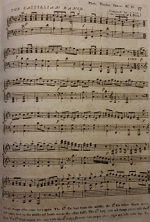
|
One of the tunes is named Earl Wellington, a title that was only used between the months of February and August of 1812. December of 1811 saw the comic pantomime of Harlequin and Padmanaba; or, The Golden Fish on stage at Covent Garden, it was described in The Gentleman's Magazine as a pantomime in which an Elephant is for the first time introduced on the regular stage! . The name Thinks I to Myself was the pseudonym used by Edward Nares for his 1812 comic novel I Says, Says I.
The contents are: The Castillian Dance (a Lady, Property), Earl Wellington (J Platts), The Nyaden (Property), The Elephant Dance or Padmanaba (J Platts), Thinks I to Myself; What! (W. Nicholson, Property).
Full Title: 30 Platts's Popular & Original Dances, for the Piano Forte, Violin, &c.; with proper figures.
Image © THE BRITISH LIBRARY BOARD, h.726.m.(10.) ALL RIGHTS RESERVED
|
#31 Platts's Popular & Original Dances
1812
James Platts |
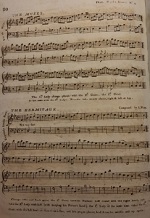
|
The contents are: The Muses, The Hermitage (J Platts), Katinka (A Lady, Property), Little Bob (A Lady, Property), Voulez Vous Danser Mademoiselle, Octavia (Property).
Full Title: 31 Platts's Popular & Original Dances, for the Piano Forte, Violin, &c.; with proper figures.
Image © THE BRITISH LIBRARY BOARD, h.726.m.(10.) ALL RIGHTS RESERVED
|
#32 Platts's Popular & Original Dances
c.1812
James Platts |
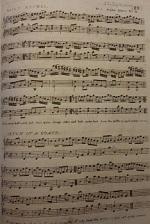
|
The copy of this work I've studied at the British Library is incomplete. The first two tunes were present in the copy I've seen, the remainder of the collection is reconstructed using Platts' catalogue of his work.
The contents are: Fairy Revels, Seven in a Coach, Mrs Mac Cloed of Rosa, The Prince Regent, Miss Fidget, Don Roderick.
Full Title: 32 Platts's Popular & Original Dances, for the Piano Forte, Violin, &c.; with proper figures.
Image © THE BRITISH LIBRARY BOARD, h.726.m.(10.) ALL RIGHTS RESERVED
|
#33 Platts's Popular & Original Dances
c.1812
James Platts |
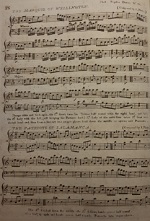
|
The contents are: The Marquis of Wellington (J Platts), The Patriots of Salamanca (J Platts), Lady Matilda Bruce, Draycot House, The Holstein Waltz (Property), The Chace.
Full Title: 33 Platts's Popular & Original Dances, for the Piano Forte, Violin, &c.; with proper figures.
Image © THE BRITISH LIBRARY BOARD, h.726.m.(10.) ALL RIGHTS RESERVED
|
#34 Platts's Popular & Original Dances
1813
James Platts |
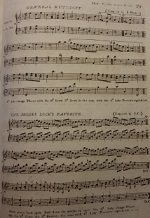
|
One of the tunes in this collection is named Miss Platoff, Platts claimed in one of his 1815 copyright disputes to have composed it in 1813. The name probably refers to the rumour that the Russian General Count Platov had proclaimed that he would bestow 200,000 rubles, and his daughter, on any of his countrymen who would bring in Bonaparte, either dead or alive (as quoted in numerous newspapers, including the Bristol Mirror, 7th November 1812). The Battle of Smolensk was fought in August 1812, Harlequin & Humpo was being performed at Drury Lane in April of 1813.
The contents are: General Kutusoff (J Platts), The Misses Lock's Favorite (I.C.), The Smolensko Waltz (J Platts), The Shamrock So Green, Miss Platoff (J Platts), Harlequin Humpo.
Full Title: 34 Platts's Popular & Original Dances, for the Piano Forte, Violin, &c.; with proper figures.
Image © THE BRITISH LIBRARY BOARD, h.726.m.(10.) ALL RIGHTS RESERVED
|
#35 Platts's Popular & Original Dances
1813
James Platts |
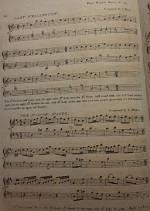
|
The Knight of Snowdown refers to a character from Walter Scott's 1810 The Lady of the Lake; a popular stage adaption had been performed in London since 1811.
The contents are: Lady Wellington (J Platts), The Moscow Waltz (J Platts), The Valentia (J Platts), The Knight of Snowdown (Property), Lady Caroline Berkley (Property), I'll Gang Na Mair to Yon Town.
Full Title: 35 Platts's Popular & Original Dances, for the Piano Forte, Violin, &c.; with proper figures.
Image © THE BRITISH LIBRARY BOARD, h.726.m.(10.) ALL RIGHTS RESERVED
|
#3 Martin Platts' Periodical Collection of Popular Dances
c.1813 |
|
The copy of this work that I've studied lacked a number on the cover, the British Library have indexed it as #3. The reference to the Battle of Salamanca dates it to be no earlier then 1812.
The contents are: The Waltzers Fancy, Count Platoff or the new Russian Dance, Lady Catherine Bertie, Harlequin and Humpo, The Battle of Salamanca, The Muses.
Full Title: 3 Martin Platts' Periodical Collection of Popular Dances, Waltzes &c. with proper figures for the Piano Forte, Harp or Violin. Published Monthly, by Messrs Clementi & Co.
|
#7 Martin Platts' Periodical Collection of Popular Dances
c.1813 |
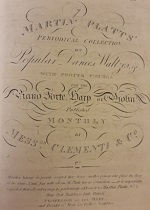
|
The contents are: The Sicilian, Master Mac Cloud, The Hornsey Dance, or Julianas Cottage, Peter Kneller, Johnny's a Coming, Herne Hill.
Full Title: 7 Martin Platts' Periodical Collection of Popular Dances, Waltzes &c. with proper figures for the Piano Forte, Harp or Violin. Published Monthly, by Messrs Clementi & Co.
Image © THE BRITISH LIBRARY BOARD, g.443.o.(35.) ALL RIGHTS RESERVED
|
#7 Martin Platts' Periodical Collection of Popular Dances
c.1813 |
|
The British Library have indexed this work, but I've not been able to study it at time of writing. It is noted to duplicate the title of the other #7 in the collection. Perhaps one of the #7 works should have been #6?
The contents are: The Maltese Dance, The Waltz of all others, The Shamrock, The Cabinet, Dracot House, Miss McCleod.
Full Title: 7 Martin Platts' Periodical Collection of Popular Dances, Waltzes &c. with proper figures for the Piano Forte, Harp or Violin. Published Monthly, by Messrs Clementi & Co.
|
#36 Platts's Popular & Original Dances
1813
James Platts |
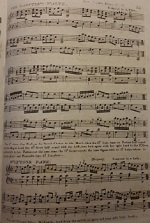
|
The Battle of Tarutino was fought in late 1812, it was a Russian victory over the French.
The contents are: The Tarutino Waltz (J Platts), Windsor Park (A Lady, Property), Brocklesbury Hall (J Platts), The Oder Waltz (J Platts), St Patricks Day in the Morning, The Marlborough or Phoenix Park.
Full Title: 36 Platts's Popular & Original Dances, for the Piano Forte, Violin, &c.; with proper figures.
Image © THE BRITISH LIBRARY BOARD, h.726.m.(10.) ALL RIGHTS RESERVED
|
Platts's Popular & Original Dances, Book 3rd
1813
James Platts |
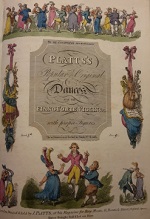
|
This volume collects together numbers 25 through 36 of James's collections. James advertised the commencement of his fourth collection of dances, for 1814 in the Morning Post newspaper for 16th November 1813. This probably implies that he had intended to issue annual collections, though he'd had to combine two years together; the start of the 4th such collection implying that the third was available for purchase.
Full Title: Book 3rd, Platts's Popular & Original Dances, for the Piano Forte, Violin, &c.; with proper figures.
Image © THE BRITISH LIBRARY BOARD, h.726.m.(10.) ALL RIGHTS RESERVED
|
#37 Platts's Popular & Original Dances
1813
James Platts |

|
An advertisement from the Morning Post newspaper for 16th November 1813 Nos 37 and 38 are ready for delivery . The Battle of the Katzbach was fought in August of 1813; the French forces at Pamplona surrendered at the end of October 1813.
The contents are: Enrico, The Katzbach Waltz (J Platts), Calder Fair, Pampeluna (J Platts), Second Thoughts are Best (A Lady, Property), Not at Home (A Lady, Property).
Full Title: 37 Platts's Popular & Original Dances, for the Piano Forte, Violin, &c.; with proper figures.
Image © THE BRITISH LIBRARY BOARD, h.726.m.(10.) ALL RIGHTS RESERVED
|
#38 Platts's Popular & Original Dances
1813
James Platts |
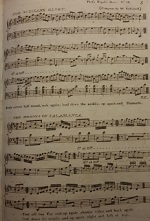
|
An advertisement from the Morning Post newspaper for 16th November 1813 Nos 37 and 38 are ready for delivery . The Allies refers to the Sixth Coalition, the Crown Prince to the former French Marshall who would become Charles XIV of Sweden.
The contents are: The Russians Glory (Underhill), The Heroes of Salamanca, The Allies (J Platts), The Crown Prince (J Platts), The Zephyr (A Lady), The Medway (A Lady), The Battuese.
Full Title: 38 Platts's Popular & Original Dances, for the Piano Forte, Violin, &c.; with proper figures.
Image © THE BRITISH LIBRARY BOARD, h.726.m.(10.) ALL RIGHTS RESERVED
|
#39 Platts's Popular & Original Dances
1813
James Platts |
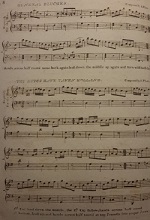
|
Many of the tunes in this collection reference battles from 1813, the Dutch have taken Holland implies a publication date of either late 1813 or early 1814. A Platts advertisement in the Morning Post newspaper for 16th November 1813 mentioned that No. 39 will be published in a few days .
The contents are: General Blucher (J Platts), The Dutch have Taken Holland (J Platts), Vittoria (J Platts), The New Leipsic Waltz (J Platts), Miss Milburns Favorite, Lose No Time (A Lady).
Full Title: 39 Platts's Popular & Original Dances, for the Piano Forte, Violin, &c.; with proper figures.
Image © THE BRITISH LIBRARY BOARD, h.726.m.(10.) ALL RIGHTS RESERVED
|
#40 Platts's Popular & Original Dances
1814
James Platts |
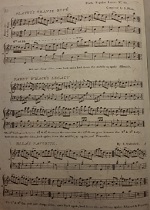
|
One of the tunes is named Zuleika, probably in reference to a character from Byron's The Bride of Abydos that was published in December 1813. The phrase Orange Boven and related terms relate to the Dutch securing independence from France in late 1813.
The contents are: Platts's Oranje Bovè (J Platts), Paddy Whack's Legacy, Ella's Favorite (I Underhill), The Prince of Orange (IT Craven), Orange Boven! (A Lady), Zuleika (A Lady), Sal Volatile (A Lady).
Full Title: 40 Platts's Popular & Original Dances, for the Piano Forte, Violin, &c.; with proper figures.
Image © THE BRITISH LIBRARY BOARD, h.726.m.(10.) ALL RIGHTS RESERVED
|
#?? Martin Platts' Periodical Collection of Popular Dances
c.1814 |
|
The copy of this number I've studied at the British Library has been left unnumbered, but the tunes are of an approximately 1814 date (based on a comparison to other vendors, including James). This doesn't fit the chronology neatly.
The contents are: Calder Fair, Enrico, The Cossack, The Regent, Orange Boven, Tom Thumb.
Full Title: ?? Martin Platts' Periodical Collection of Popular Dances, Waltzes &c. with proper figures for the Piano Forte, Harp or Violin. Published Monthly, by Messrs Clementi & Co.
|
#41 Platts's Popular & Original Dances
1814
James Platts |
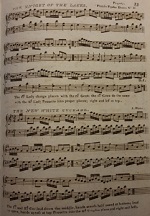
|
Two of these dances featured in James' legal disputes of 1815, he asserted that he had bought the rights to The Saxon Dance and Arabella from Mr Bohmer in 1814. The copy of this work that I've studied featured an annotation to Paddy Carey's Ghost, someone had added in ink composed by J Platts ; it's likely that this tune replaced Paddy Carey's Fortune or Irish Promotion after Platts lost an 1814 copyright dispute with the rival firm of Button & Whitaker. That in turn implies that the copy I've studied is not a first edition, but a subsequently modified edition.
The contents are: The Knight of the Lakes (Property), The New White Cockade (J Platts), Lord St Orville, The Saxon Dance, Arabella, Paddy Carey's Ghost.
Full Title: 41 Platts's Popular & Original Dances, for the Piano Forte, Violin, &c.; with proper figures.
Image © THE BRITISH LIBRARY BOARD, h.726.m.(10.) ALL RIGHTS RESERVED
|
#42 Platts's Popular & Original Dances
1814
James Platts |
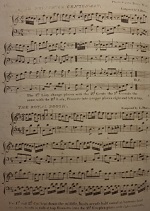
|
The Brunswick Centenary refers to the 100 years that the the Hanoverian dynasty had ruled Britain since George I came to the throne in 1714. The Grand Jubilee was celebrated in August of 1814, the tunes in this collection reference the 1st August celebrations.
The contents are: The Brunswick Centenary (J Platts), The Royal Booth (J Platts), The Pagoda (J Platts), The Jubilee Bells (J Platts), The Rocket (Property), The Temple of Concord (J Platts).
Full Title: 42 Platts's Popular & Original Dances, for the Piano Forte, Violin, &c.; with proper figures.
Image © THE BRITISH LIBRARY BOARD, h.726.m.(10.) ALL RIGHTS RESERVED
|
#43 Platts's Popular & Original Dances
1814
James Platts |

|
This set was advertisement to be available in the Morning Post for 5th December 1814. The tune named The Forest of Bondy is a reference to the stage adaption of Dog of Montargis from 1814; Jean de Paris was on stage at Drury Lane from October 1814.
The contents are: The Forest of Bondy (Property J Platts), Anti-Attrition (Property, Miss Hardacre), Mickleham Downs (Property of the Composer), Jean de Paris (J Platts), Macbeth or the Weird Sisters, Storace, The Bed of Roses.
Full Title: 43 Platts's Popular & Original Dances, for the Piano Forte, Violin, &c.; with proper figures.
Image © THE BRITISH LIBRARY BOARD, h.726.m.(10.) ALL RIGHTS RESERVED
|
#44 Platts's Popular & Original Dances
c.1814
James Platts |
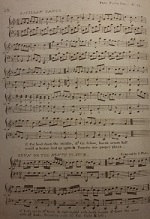
|
A Platts advertisement issued in the Morning Post for 5th December 1814 mentioned that Zeyn, or the Ninth Statue would be published next week ; it refers to a production on stage at Drury Lane from early December 1814.
The contents are: Sicilian Dance, Zeyn or the Ninth Statue (J Platts), Dal Caro's Hornpipe, The Regents Favorite, Tom Thumb, St Julian's Cottage, Hyde House or Miss Smith's Fancy (Property of the Composer).
Full Title: 44 Platts's Popular & Original Dances, for the Piano Forte, Violin, &c.; with proper figures.
Image © THE BRITISH LIBRARY BOARD, h.726.m.(10.) ALL RIGHTS RESERVED
|
#8 Martin Platts' Periodical Collection of Popular Dances
c.1815 |

|
The contents are: Castle Durrow, The Sociable, The Saxon Dance, Prince Blucher's Farewell, The Forest of Bondy, Miss Grunde.
Full Title: 8 Martin Platts' Periodical Collection of Popular Dances, Waltzes &c. with proper figures for the Piano Forte, Harp or Violin. Published Monthly, by Messrs Clementi & Co.
Image © THE BRITISH LIBRARY BOARD, g.443.o.(35.) ALL RIGHTS RESERVED
|
#45 Platts's Popular & Original Dances
c.1815
James Platts |
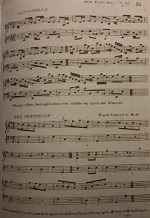
|
The tune named Petronella is of some interest for modern dancers as it's a staple of modern Scottish Country Dancing, composition is usually ascribed to Nathaniel Gow (it was included in his 1820 No 1. The Cries of Edinburgh). As far as I can discern it was originally composed in 1810 by John Parry under the name The Persian Dance (Morning Post, 25th May 1810) and was composed in compliment to his Excellency Mirza Abul Hassan (Moring Post, 4th May 1810); it was widely published c.1810 under various names, including in Platts' 19th Number. Platts may have been the first to adopt the name Petronella for the tune.
The name Boubikir Moussin references a character from the 1814 The Ninth Statue.
The contents are: Petronella, The Pertholly (W.M.), Speed the Plough, Boubikir Moussin (S Denman), Caller Herring, Thame Park (J Platts), Hurst Castle (J Taylor).
Full Title: 45 Platts's Popular & Original Dances, for the Piano Forte, Violin, &c.; with proper figures.
Image © THE BRITISH LIBRARY BOARD, h.726.m.(10.) ALL RIGHTS RESERVED
|
#46 Platts's Popular & Original Dances
c.1815
James Platts |
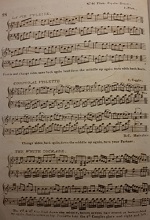
|
The name La Pie Voleuse refers to a melodrama on stage at Covent Garden from September 1815.
The contents are: La Pie Voleuse (J Platts), Corporal Violette (I Coggins), The White Cockade, Waterloo or La Belle Alliance (J Platts), The Fall of Leipsic, Duke de Berri (Edward Parrish), Zemuda or the Banks of the Rhyne (Edward Parrish).
Full Title: 46 Platts's Popular & Original Dances, for the Piano Forte, Violin, &c.; with proper figures.
Image © THE BRITISH LIBRARY BOARD, h.726.m.(10.) ALL RIGHTS RESERVED
|
#9 Martin Platts' Periodical Collection of Popular Dances
c.1815 |
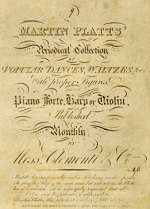
|
The contents are: Battle of Waterloo, Miss O'Neil's Waltz, John of Paris, The Return, Ma Petite Parole, Trip to Paris.
Full Title: 9 Martin Platts' Periodical Collection of Popular Dances, Waltzes &c. with proper figures for the Piano Forte, Harp or Violin. Published Monthly, by Messrs Clementi & Co.
|
#10 Martin Platts' Periodical Collection of Popular Dances
c.1816 |
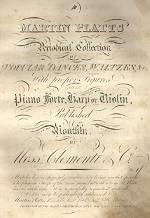
|
The contents are: Lady Mary or Preabrasinski, The New May Moon, La Belle Annette, The Batteuse Country Dance, Prince Blucher's favorite Dance, The Batteuse.
Full Title: 10 Martin Platts' Periodical Collection of Popular Dances, Waltzes &c. with proper figures for the Piano Forte, Harp or Violin. Published Monthly, by Messrs Clementi & Co.
|
#12 Martin Platts' Periodical Collection of Popular Dances
c.1816 |
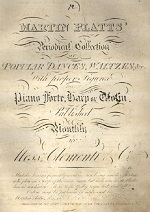
|
The contents are: Captain Wyke, Ragley Park, Don Giovanni, The Slave, Rob Roy, Lion House.
Full Title: 12 Martin Platts' Periodical Collection of Popular Dances, Waltzes &c. with proper figures for the Piano Forte, Harp or Violin. Published Monthly, by Messrs Clementi & Co.
|
#47 Platts's Popular & Original Dances
c.1816
James Platts |

|
The reference to The Beggar's Bush probably dates this collection to 1816, the play of the same name was revived at Drury Lane in mid-December 1815.
The contents are: Lanesborough House (J Platts), Tanfield Hall (Property), The Beggar's Bush (Property), Miss Wentworths Favorite (Property), Loch Leven (Property), Dunbar Castle (Property).
Full Title: 47 Platts's Popular & Original Dances, for the Piano Forte, Violin, &c.; with proper figures.
Image © THE BRITISH LIBRARY BOARD, h.726.m.(10.) ALL RIGHTS RESERVED
|
#48 Platts's Popular & Original Dances
1816
James Platts |
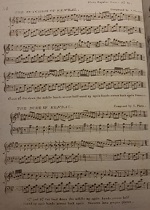
|
The contents of this work were advertised as just published in the Morning Post newspaper for 31st May 1816. The tune named Meg Merrelies was named after a character in Walter Scott's 1815 Guy Mannering; Platts claimed to have composed this tune, it went on to be moderately popular.
The contents are: The Dutchess of Kendal (J Platts), The Duke of Kendal (J Platts), Meg Merrelies (J Platts), The Young May Moon, The Pavillion (J Platts), The Isle of France.
Full Title: 48 Platts's Popular & Original Dances, for the Piano Forte, Violin, &c.; with proper figures.
Image © THE BRITISH LIBRARY BOARD, h.726.m.(10.) ALL RIGHTS RESERVED
|
Platts's Popular & Original Dances, Book 4th
1816
James Platts |
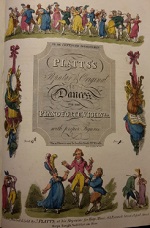
|
This volume collects together numbers 37 through 48 of James's collections. The date of publication is presumed to be 1816 based on the content, though the address on the cover was left as 83 Berwick Street despite James having moved by 1816. Presumably he didn't consider it worth his effort to update the plates.
Full Title: Book 4th, Platts's Popular & Original Dances, for the Piano Forte, Violin, &c.; with proper figures.
Image © THE BRITISH LIBRARY BOARD, h.726.m.(10.) ALL RIGHTS RESERVED
|
#?? Martin Platts' Periodical Collection of Popular Dances
c.1817 |
|
The copy of this number I've studied at the British Library has been left unnumbered, but the reference to Grand Duke Nicholas hints at his visit to England in late 1816; the The Broken Sword was being performed from 1816, and Waterloo implies a date no earlier then 1815. This could be number 13 in Martin's series.
The contents are: Lord Exmouth's Return, The Waterloo, The Duchess of Gloucester, La Jolie Angloise, The Broken Sword, The Grand Duke Nicholas.
Full Title: ?? Martin Platts' Periodical Collection of Popular Dances, Waltzes &c. with proper figures for the Piano Forte, Harp or Violin. Published Monthly, by Messrs Clementi & Co.
|
My Grandmother's Quadrilles
1820, 1821
James Platts |
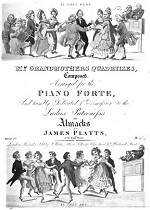
|
The first edition of this work was advertised as just published in The Times newspaper for 8th November 1820; a second edition was advertised as just published in the Morning Post newspaper for 8th March 1821.
The contents are: Bella Cosa, Le Retour de Londres, Le Garcon Qui Jeu, L'Arethusa, Rule Britannia, Duports Waltz.
Full Title: My Grandmothers Quadrilles, Composed for the Piano Forte, and humbly Dedicated sans Permission to the Ladies Patroness of Almacks by James Platts of the King's Theatre. Book 1st.
|
#51 Platts's Popular & Original Dances
1821
James Platts |
|
The contents of this work were advertised as just published in the Morning Post newspaper for 8th March 1821.
The contents include: Kenilworth Castle, The Countess of Leinster, The Cyclops, The Andalusian Waltz.
Full Title: 51 Platts's Popular & Original Dances, for the Piano Forte, Violin, &c.; with proper figures.
|
James Platts was one of the more interesting dance publishers of his generation; he was responsible for some high quality publications, but also for some of the most extreme copying I've yet discovered. There are mysteries to his story that are yet to be explained. We'll leave this investigation here, if you have any additional information to share regarding the Platts family, do please Contact Us as we'd love to know more.
|

